Travis House Archaeological Report, Block 14 Building 4 Lot J & KOriginally entitled: "The Travis House (Lot K) Site Block 14 Area G Colonial Lots J and K Report on the Artifacts Excavated During the 1962-1963 Volume II"
Colonial Williamsburg Foundation Library Research Report Series - 1293
Colonial Williamsburg Foundation Library
Williamsburg, Virginia
1990
THE TRAVIS HOUSE (LOT K) SITE
Block 14, Area G
Colonial Lots J and KREPORT ON THE ARTIFACTS EXCAVATED DURING 1962-1963
Volume II
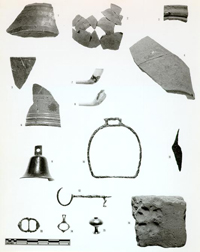 Figure 1. Artifacts from deposit made between 1725-1750.
Figure 1. Artifacts from deposit made between 1725-1750.
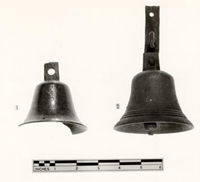 Figure 2. Bell from deposit made between 1725 and 1750 and later bell form Cole Shop showing method of attachment to spring.
Figure 2. Bell from deposit made between 1725 and 1750 and later bell form Cole Shop showing method of attachment to spring.
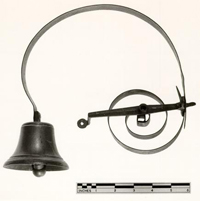 Figure 3. Spring bell in the possession of Mr. J. Ricks Wilson.
Figure 3. Spring bell in the possession of Mr. J. Ricks Wilson.
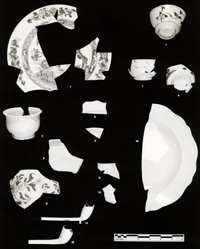 Figure 4. Artifacts from cellar hole on Lot K, deposited between 1782 and 1790, see also Figs. 5 and 6.
Figure 4. Artifacts from cellar hole on Lot K, deposited between 1782 and 1790, see also Figs. 5 and 6.
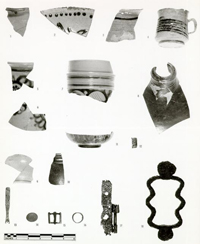 Figure 5. Artifacts from cellar hole on Lot K, deposited between 1782 and 1790, see also Figs. 4 and 6.
Figure 5. Artifacts from cellar hole on Lot K, deposited between 1782 and 1790, see also Figs. 4 and 6.
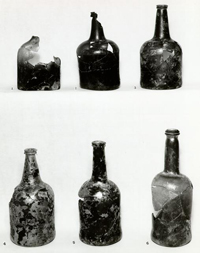 Figure 6. Bottles associated with artifacts in Figs. 4 and 5, deposited between 1782 and 1790.
Figure 6. Bottles associated with artifacts in Figs. 4 and 5, deposited between 1782 and 1790.
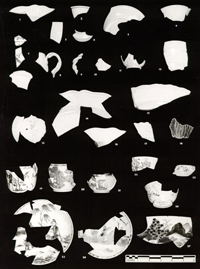 Figure 7. Ceramics from foundations of SW and NW closets and the builders' trench for the west wall, deposited between 1782 and 1790.
Figure 7. Ceramics from foundations of SW and NW closets and the builders' trench for the west wall, deposited between 1782 and 1790.
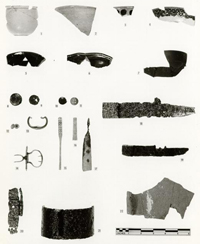 Figure 8. Artifacts deposited when the NW closet was destroyed and a new west all built, between 1782 and 1790.
Figure 8. Artifacts deposited when the NW closet was destroyed and a new west all built, between 1782 and 1790.
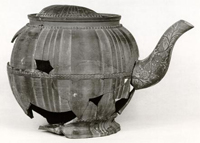 Figure 9. Black basalt teapot found with the artifacts in Figure 8 and deposited between 1782 and 1790.
Figure 9. Black basalt teapot found with the artifacts in Figure 8 and deposited between 1782 and 1790.
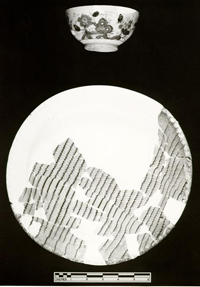 Figure 10. Slipware dish associated with artifacts in Figs. 8 and 9 and deposited between 1782 and 1790. Chinese porcelain tea bowl from under foundation for NW closet and deposited between 1782 and 1790.
Figure 10. Slipware dish associated with artifacts in Figs. 8 and 9 and deposited between 1782 and 1790. Chinese porcelain tea bowl from under foundation for NW closet and deposited between 1782 and 1790.
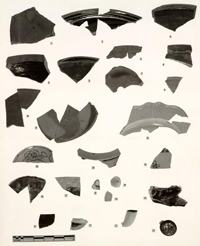 Figure 11. Ceramics and small finds from trash deposit made between 1785 and 1790.
Figure 11. Ceramics and small finds from trash deposit made between 1785 and 1790.
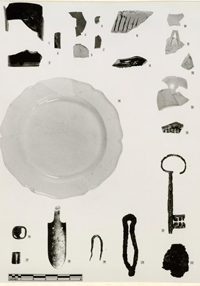 Figure 12. Artifacts from oval rubbish pit deposited 1780 and 1790.
Figure 12. Artifacts from oval rubbish pit deposited 1780 and 1790.
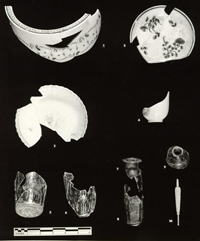 Figure 13. Artifacts from privy pit deposited between 1790 and 1810.
Figure 13. Artifacts from privy pit deposited between 1790 and 1810.
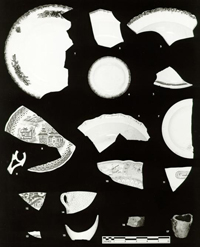 Figure 14. Artifacts from below the south closet deposited after 1830 and prior to 1840.
Figure 14. Artifacts from below the south closet deposited after 1830 and prior to 1840.
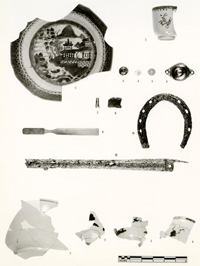 Figure 15A & B. Items 1-11 from below the south closet are associated with the artifacts in Fig. 14, deposited after 1830 and prior to 1840. Items 104 are from a trash deposit made between 1785-1790.
Figure 15A & B. Items 1-11 from below the south closet are associated with the artifacts in Fig. 14, deposited after 1830 and prior to 1840. Items 104 are from a trash deposit made between 1785-1790.
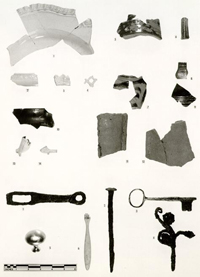 Figure 16A & B. Items 1-12 are miscellaneous artifacts of unusual interest from various contexts. Items 1-6 are artifacts from destruction layer, in[illegible]
Figure 16A & B. Items 1-12 are miscellaneous artifacts of unusual interest from various contexts. Items 1-6 are artifacts from destruction layer, in[illegible]
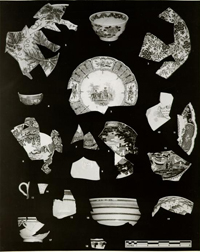 Figure 17. Ceramics from various contexts.
Figure 17. Ceramics from various contexts.
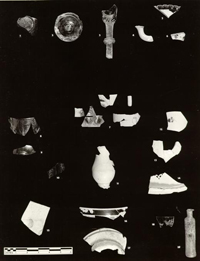 Figure 18. Ceramics and glass from various contexts.
Figure 18. Ceramics and glass from various contexts.
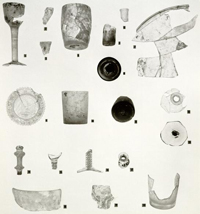 Figure 19. Glass from various contexts.
Figure 19. Glass from various contexts.
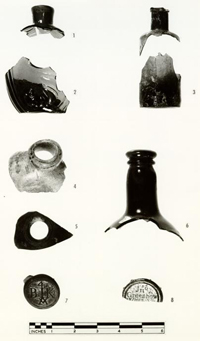 Figure 20. Glass form various contexts.
Figure 20. Glass form various contexts.
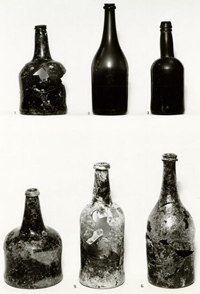 Figure 21. Beverage bottles from various archaeological contexts.
Figure 21. Beverage bottles from various archaeological contexts.
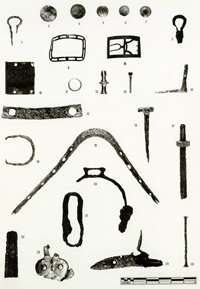 Figure 22. Items of brass and iron from various archaeological contexts.
Figure 22. Items of brass and iron from various archaeological contexts.
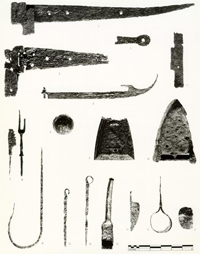 Figure 23. Iron items from various archaeological contexts.
Figure 23. Iron items from various archaeological contexts.
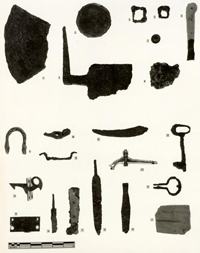 Figure 24. Miscellaneous items of iron, brass, bone, stone, etc., from various archaeological contexts.
Figure 24. Miscellaneous items of iron, brass, bone, stone, etc., from various archaeological contexts.
TABLE OF CONTENTS.
- Introduction
- Figures 1 through 24
- Photograph Negative Numbers
Introduction
The Travis House produced an unusually high number of artifact groups which on the basis of archaeological or historical evidence could be tightly dated. For this reason the usual artifact report format of grouping by type of object was abandoned. Instead the significant objects of each group are photographed and described together.
The groups have been arranged in chronological order and their dates of deposition cover the period from c.1725-1875. Several of them are associated with the various changes to the Travis House itself while others are related to the outbuildings of the various periods.
As with every site the Travis House produced a number of significant items from otherwise unimportant or disturbed groups. Therefore, at the end of the report these have been collected together by type of object. Wherever possible this report has been updated to include references to identical items from subsequent sites but as several reports are still in course of preparation, full photographic references cannot always be produced.
The reader's attention is drawn to the as yet un-resolved relationship between the Travis, Custis, and Post office sites. Further research both historical and archaeological will be necessary before the problem can be solved.
| Figure 1. | Artifacts from deposit made between 1725-1750. |
| Figure 2. | Bell from deposit made between 1725 and 1750 and later bell from Cole Shop showing method of attachment to spring. |
| Figure 3. | Spring bell in the possession of Mr. J. Ricks Wilson. |
| Figure 4. | Artifacts from cellar hole on Lot K, deposited between 1782 and 1790, see also Figs. 5 and 6. |
| Figure 5. | Artifacts from cellar hole on Lot K, deposited between 1782 and 1790, see also Figs. 4 and 6. |
| Figure 6. | Bottles associated with artifacts in Figs. 4 and 5, deposited between 1782 and 1790. |
| Figure 7. | Ceramics from foundations of SW and NW closets and the builders' trench for the west wall, deposited between 1782 and 1790. |
| Figure 8. | Artifacts deposited when the NW closet was destroyed and a new west wall built, between 1782 and 1790. |
| Figure 9. | Black basalt teapot found with the artifacts in Figure 8 and deposited between 1782 and 1790. |
| Figure 10. | Slipware dish associated with artifacts in Figures 8 and 9 and deposited between 1782 and 1790. Chinese porcelain tea bowl from under foundation for NW closet and deposited between 1782 and 1790. |
| Figure 11. | Ceramics and small finds from trash deposit made between 1785 and 1790. |
| Figure 12. | Artifacts from oval rubbish pit deposited 1780 and 1790. |
| Figure 13. | Artifacts from privy pit deposited between 1790 and 1810. |
| Figure 14. | Artifacts from below the South closet deposited after 1830 and prior to 1840. |
| Figure 15A. | Items 1-11 from below the south closet are associated with the artifacts in Figs. 14, deposited after 1830 and prior to 1840. |
| Figure 15B. | Items 1-4 are from a trash deposit made between 1785-1790. |
| Figure 16A. | Miscellaneous artifacts of unusual interest from various contexts. |
| Figure 16B. | Artifacts from destruction layer inside NE outbuilding, deposited by 1875. |
| Figure 17. | Ceramics from various contexts. |
| Figure 18. | Ceramics and glass from various contexts. |
| Figure 19. | Glass from various contexts. |
| Figure 20. | Glass from various contexts. |
| Figure 21. | Beverage bottles from various archaeological contexts. |
| Figure 22. | Items of brass and iron from various archaeological contexts. |
| Figure 23. | Iron items from various archaeological contexts. |
| Figure 24. | Miscellaneous items of iron, brass, stone, bone, etc., from various archaeological contexts. |
Figure 1
This group of artifacts was recovered from a trash deposit made early in the second quarter of the eighteenth century, close to the southeast corner of the Research Department.1
- 1.Section of pan of thick, buff, ochre-flecked, lead-glazed coarse earthenware with flat base, almost vertical sides and rim rising sharply on the interior and smoothed down on the exterior to form a thickened angle with the wall. Base diam: 10". Height: 3". Tidewater, Virginia origin, probably Yorktown. [2723. E.R. 600C-14.G.]
- 2.Hemispherical bowl of buff, ochre-flecked, Colono-Indian pottery with rim smoothed off towards the interior. Probably a product of the Pamunkey tribe potters.2 Height: 2½". [2724. E.R. 600C-14.G.]
- 3. & 4.Rim and base fragments of barrel-shaped jar of coarse earthenware with internal clear, lead glaze. The rim has been folded back to form a collar with pressure applied in its center.
While these sherds were recovered from a trash pit, the rim [2725. E.R. 578G-14.G.] was found in the undisturbed filling of a cellar1 and two more fragments were found in the back-filling of a modern utility trench cut through the same cellar. Further fragments were found in a post hole [E.R. 595-14-G.] with colonial artifacts, and were mended to the fragments from E.R. 600C-14.G.
Rim sherd [2725a. E.R. 578G-14.G.]
Base sherd [2725b. E.R. 600C-14.G.] - 5. & 6.Rim and base sherd of straight-sided, quart tankard of brown salt-glazed stoneware of the type known as "Fulham", but also made elsewhere in London and England. The upper portion of the tankard was dipped in a ferruginous clay slip which fired to a mottled brown, while the lower portion remained a grey-brown. Below the plain rim, with its single exterior groove, is an impressed "WR" stamp with a crown above it. Although this is an excise stamp of William III, its presence on the tankard does not infer that it was necessarily potted between 1688 and 1702. For reasons which have never been satisfactorily explained, such stamps continued to be used on wares of this kind until the end of the eighteenth century. The lower portion of the body is ornamented with single ridge, cordon and double ridge and the foot swells slightly. Base diam: 4". Height: approx. 6". English. [2726. E.R. 600C-14.G.]
- 7.Clay tobacco pipe without heel or spur. Stem hole diam: 5/64". English. Manufactured in the first quarter of the eighteenth century. [2727. E.R. 600C-14.G.]
- 8.Clay tobacco pipe of similar form to No. 7, but with "RT" incise on back of bowl and in circular cartouche on right hand side of bowl with "R TIPPET" in raised capital letters. Similar pipes have been found at The Prentis House and the Ravenscroft lot [2179.-28.F.4.] and are assumed to be the work of Robert Tippet known to have operated in Bristol after 1713.1 Stem hole diam: 5/64". English. [2728. E.R. 600C-14.G.]
- 9.Tin-plated brass table bell with widely everted sound bow and domed crown to which a lug handle is attached. The latter has single, central hole, a feature present on a spring bell (Figure 3) in the possession of Mr. J. Ricks Wilson who kindly allowed it to be photographed for this report. This bell is attached to the spring by an iron rivet and there seems no doubt that the Travis bell was used in a similar manner. The now missing clapper was attached to an iron ring inside the crown. Diam. of sound bow: 3¼". Total height: 3 3/8". [2729. E.R. 600C-14.G.]
- 10.Iron stirrup with round-sectioned sides, rectangular loop for the leather and solid oval footplate. Similar in shape and size to an example found at the Anthony Hay site in a deposit made about 1770 [2732.E.R. 288-28.D.].1 A further fragmentary example was found in a disturbed group on the Travis House site, 3137. E.R. 457-14.G. Total height: 5 ¾". [2730. E.R. 60OC-14.G.]
- 11.Small iron knife-like object with rounded back and straight blade; the flat tang tapers to a point. This would appear to be the same class of object (still unidentified) that has been found at Tutter's Neck in a context of 1725-1735,2 Rosewell, Virginia, 1763-1772,3 the Peter Scott site [1319. E.R. 72E-13.D.] prior to 1775,4 and Post Office (S. Henry) site [2304, 2305, &2306. E.R. 384A-15.A.] in Williamsburg, 1765-1775,1 Clay Bank, Virginia, c.1700,2 and George Reid House [2722. E.R. 672C-1l.E.] context post 1790 to site only a few. See also Figure 24, No. 12 for another object of this class. Length: 4". [2733. E.R. 600C-14.G.]
- 12.Fragmentary iron key with oval bow, solid pin, and web incomplete. Length: 5¼". [2734. E.R. 600C-14.G.]
- 13.Small, crudely cast, brass buckle with poor decoration of large beading. Buckles of this type were found during excavations at Jamestown3 and are generally of late seventeenth century date. Length: 2 1/8". Width: 1 7/8". Possibly American. [2735. E.R. 600C-14.G.]
- 14.Small, cast-brass drop handle consisting of an oval, on the broad top of which rests an inverted group of three leaves. From the top of the latter projects a recessed, flattened, triangular lug pierced by a round hole. A rosette appears on each of the narrow ends of the oval and a smaller group of three leaves at its lowest extremity. This is a type of drop handle common in the latter years of the seventeenth century.1 Length: 1 ¾". Width: 1 1/8". [2736. E.R. 600C-14.G.]
- 15.Oval, brass, two-piece door knob with circular hole in top. A similar knob was found on the Ravenscroft lot [2211.-28.F.4.]. [2750. E.R. 600C-14.G.]
- 16.Portion of brick bearing imprint of dog's paw. [2739. E.R. 600C-14.G.]
Figure 2
Left:
Bell excavated at the Travis House site from a rubbish deposit made early in the second quarter of the eighteenth century. For a full description see Figure 1, No. 9. Height: 3 3/8". Diameter of sound bow 3 ¼".
[2729. E.R. 600C-14.G.]
Right:
Bell found at the site of the Cole Shop with similar iron lug to the Travis example but with a portion of the iron spring still attached to the lug by an iron rivet. A nail with the point removed has been driven through a hole above the rivet and bent over on itself to form a loop. Height of bell and lug: 3 ½". Diameter of sound bow: 3 ½".
[3900.-13.D.1.]
Figure 3
Spring bell in the possession of Mr. J. Ricks Wilson of Williamsburg showing method of attaching both the bell to the spring and the latter to the mounting.
Figure 4
Artifacts from the filling of the cellar hole on Lot K to the east of the Travis House. These were discarded between 1782 and 1790. 1
- 1.Round plate of Chinese export porcelain decorated in blue under the glaze, shallow bowl, small footring, brown edge, and sloping urn. The latter is decorated with a series of floral sprays, the bowl with alternating diaper and floral zones and the center with an Oriental scene. Diameter: 8 ¾". Height: 7/8". Chinese style. [2840. E.R. 598A, 579E, 578D-14.G.]
- 2.Small hemispherical, tea bowl of Chinese export porcelain with iron oxide painted on rim and underglaze blue, hand-painted decoration of flowing floral sprays enclosed by two lines on the exterior. The footring is proportionately tall and unglazed on the lower surface. The interior has two lines, one running close to the rim and the other enclosing a floral spray in the center of the bowl. A similarly decorated cup with slightly more angled sides was found on the Anthony Hay site in deposits made prior to 1780 [2842. E.R. 243C, E, & G-28.D.]. Chinese. [2841. E.R. 578D-14.G.]
- 3.Tea bowl of thin Chinese export porcelain with a badly eroded overglaze floral design on the exterior and apparently plain interior. Chinese. Rim diam: 3". [2843. E.R. 579E-14.G.]
- 4.Base portion of tea bowl of Chinese export porcelain, plain interior but with exterior decoration of underglaze blue landscape, flowers, and trees with slight traces remaining of overglaze additions in red and gold. Two cups with similar underglaze blue decoration were found south of the Period IV extension, Fig. 15B, No. 2 and 3, [2845. E.R. 563A-14.G. and 2846. E.R. 563A-14.G.]. Chinese. [2844. E.R. 598A-14.G]
- 5.Small undecorated ointment pot of tin-glazed earthenware, with everted rim and sides incurving to a footring within which the partially glazed base rises. English. Height: 2¼". [2848. E.R. 597E-14.G.]
- 6.Fragment of hemispherical bowl of tin-glazed earthenware (delftware) with underglazed yellow band close to rim enclosed at top and bottom by green and blue lines respectively. An overglaze wavy red line is superimposed on the yellow band. English, probably Liverpool. [2847. E.R. 579E-14.G.]
- 7.Rim sherd of punch bowl of tin-glazed earthenware with external floral decoration in underglaze blue. English. [2849. E.R. 578D, 578A-14.G.]
- 8.Marly fragment of small, oval, butter dish stand of white saltglazed stoneware with molded diaper pattern between foliations. English. [2850. E.R. 587A-14.G.]
- 9.Rim sherd of saucer of white saltglazed stoneware, plain on exterior and with incised cobalt-filled swags pendant from rim on the interior. A similarly decorated saucer was found at the Anthony Hay site [2852. E.R. 365-28.D.] in a deposit made between 1770 and 1780 and on the Post office (S. Henry) site [1782. E.R. 384A, 391A-15.A.] in a deposit of 1765-1775. English. [2851. E.R. 578H-14-G.]
- 10.Half of wavy-edged plate of white saltglazed stoneware with molded barley pattern on the rim, deep bowl and flat base. English. Depth: 1 3/8". [2853. E.R. 579E-14.G.]
- 11. & 12.Small banded, barrel-shaped pitcher of creamware, with bead and reel decoration molded in relief close to recessed base and everted rim. The handles are double, twisted and intertwined and joined to the body with floral terminals including an unusual trefoil flower. The latter appears in a terminal suggested by Townerl to be a product of the Leeds Pottery prior to 1775, a date and identification borne out by the presence of the bead-and-reel molding. English. [2854. E.R. 579D, 579E, 580A-14-G.]
- 13.Clay tobacco pipe2 with truncated egg-shaped bowl, and with long spur. The angle of the bowl and stem suggests a date at the end of the eighteenth century. Stem hole diam: 4/64". [2855. E.R. 578D-14.G.]
- 14.Clay tobacco pipe without heel or spur. Second quarter of eighteenth century. Stem hole diameter: 4/64". [2856. E.R. 578D-14.G.]
Figure 5
Further artifacts from the filling of the cellar hole on Lot K to the east of the Travis House. These were discarded between 1782 and 1790.1
- 1.Rim of coarse earthenware pitcher or pipkin, gravel-tempered and with clear lead glaze on interior and upper surface of rim. The latter is everted and the shoulders slope rapidly. There is a small portion of a pulled-out pouring spout remaining. This is possibly a product of one of the Tidewater kilns. [2857. E.R. 578D-14.G.]
- 2.Rim fragment of round, bat-molded earthenware dish, unglazed on the back. The front is slipped with dots of a dark brown slip applied close to the notched rim. A similarly colored and applied design of unknown character appears in the center of the dish. Diam: approx. 11". English, probably Staffordshire. [2858. E.R. 579E, 578D-14.G.]
- 3.Neck-rim fragment of pitcher of earthenware with straight neck, gently sloping shoulders and flaring rim. The body is covered with a slip over which a band of manganese-stained slip has been applied below the rim, the whole covered with a yellowish glaze. A similar pitcher was found at the Semple House, Francis Street [21-2l.B.]. English, probably Staffordshire. [2859. E.R. 578D-14.G.]
- 4.Small, handled mug of buff clay slipped with a similar clay, decorated with thin horizontal trails of manganese-dyed slip and then inverted into a yellowish lead glaze down to the point where the body slopes into the foot. The base is flat, the rim slightly everted and the strap handle is luted to the lower portion of the body. The cup lacks the dots usually associated with this ware, but a similar though larger cup from a deposit of a comparable date on the Post Office site (2314. E.R. 384A-15.A.] is likewise without dots. Rim diam: 2½". Height: 2 ¾". Base diam: 2 1/8". English. [2315. E.R. 5.79E-14.G.]
- 5. & 6.Rim and body fragment of a storage jar of Rhenish saltglazed stoneware with flattened rim, recessed to take a lid and square cut on exterior surface. The body slopes gently outward below a number of cordons, a pair of which enclose a cobalt-filled band. Below this the body is decorated with stamped rosettes (cobalt-filled) with a painted floral design surrounding them and also around the bases of the handles. A horizontal round-sectioned handle, decorated with cobalt splashes, joins to the body fragment. (Not illustrated). Jars of similar shape and character but of greater size were found on the Coke-Garrett Site (3145 & 3146-27.A.). Rhenish. [2860. E.R. 587A, 597A, 597E-14.G.]
- 7.Rim of straight-sided tankard of Rhenish saltglaze stoneware with a smooth zone immediately below the plain rim. The central zone of the body is decorated with an indecipherable design of incised lines and cobalt-filled areas. Above this, below the plain zone are nine cordons with cobalt infilling in two cases. Rim diam: 3 ¾". Rhenish, Westerwald. [2861. E.R. 582C-14.G.]
- 8.Neck of jug or bottle of brown saltglazed stoneware with cordoned neck and heavy rim. The vessel has been held by the base and dipped into a ferruginous slip which has penetrated the neck for a short distance. English. [2862.E.R. 578D-14.G.]
- 9.Base of small jug or bottle of brown saltglazed stoneware with globular sides and small footring. The upper portion of the vessel has been dipped in a ferruginous slip and has fired brown, while the lower is a grey-buff. English. [2863. E.R. 579E-14.G.]
- 10.Rim fragment of pipkin of brown saltglazed stoneware with thickened rim and three cordons, below which the body appears to swell slightly. The exterior of this vessel has been coated with a ferruginous lip which has fired to a deep brown. Possibly a product of the Yorktown kilns in the second quarter of the eighteenth century. [2864. E.R. 579E-14.G.]
- 11.Saucer, clouded ware, cream-coloured body, a combination of oxides creating a black, grey, yellow and green mottling on both surfaces. The footring is square-cut and the base cream colored with black blotches. Rim diam: 4 1/8". Height: 1¼". Footring diam: 2". English. Manufactured 1745-1765. [2865. E.R. 578D, 598A-14.G.]
- 12.Small portion of mold-made strap handle of green-glazed ware of the type perfected by Josiah Wedgwood in 1759 and shortly afterwards copied by many other English potters. The handle has vertical grooving running from an ear and a central spine on the underside. This is probably from a vessel of one of the "pineapple, cauliflower, or cabbage" patterns developed in the period of 1760-1775. English. [2866. E. R. 578A-14.G.]
- 13.Bone back of small double-ended, double-facing brush, one end having only four pairs of bristles in two rows making them widely spaced. The other end (and the reverse side) has three rows of bristles exceedingly close together. [2867. E.R. 578D-14.G.]
- 14.Tin plated, round brass button, slightly convex face and corresponding concave reverse with brass loop. Diam: 1". [2868. E.R. 578D-14.G.]
- 15.Rectangular brass buckle1 from harness, the strap retaining bar being set back, thus raising the face of the buckle above the thickness of the leather. Iron tang. Width: 1¼". [2870. E.R. 578D-14.G.]
- 16.Small brass curtain ring flattened on either face and with bevelled edge. Diam: 1". [2869. E.R. 578B-14-G.]
- 17.Fragment of iron H or HL hinge. [2871. E.R. 578A-14-G.]
- 18.Iron patten with wavy sides and circular lugs each with pair of original nails still in position. Total length: 6 ¾". [2872. E.R. 579D-14-G.]
Figure 6
Bottles found with artifacts from the filling of the cellar hole on Lot K to the east of the Travis House. These were discarded between 1782 and 1790.1 All are assumed to be of English origin unless otherwise stated.
- 1.Octagonal, light green glass beverage bottle with sides of uneven width and sloping shoulder. A close parallel for this bottle is in the Department of Collections [56-202]. It bears a seal on which is the legend "Jos Woods 1740". Existing height: 5 ¾". [2817. E.R. 578D-14.G.]
- 2.Short, cylindrical dark green beverage bottle with shoulder slightly broader than the base, shallow basal kick and down-tooled string-rim. This bottle has been blown into a patterned mold and bears a raised double W immediately below the shoulder. As far as can be ascertained, this is a unique form of decoration. Height: 8½". [2818. E.R. 578D-14.G.]
- 3.Short, cylindrical glass beverage bottle of dark green metal with domed kick, flattened mouth, downtooled string-rim and sloping shoulder. Height: 9". [2819. E.R. 579E-14.G.]
- 4.Cylindrical glass beverage bottle of olive green metal, with sloping shoulder, flattened basal kick, down-tooled string-rim and slightly everted mouth. Height: 8½". [2821. E.R. 578D-14.G.]
- 5.Cylindrical glass beverage bottle of bubbly green metal with flattened basal kick, sloping shoulder, down-tooled string-rim and everted mouth. Height: 9¼". [2822. E.R. 578D-14.G.]
- 6.Tall, cylindrical glass beverage bottle of pale emerald green bubbly metal, shallow kick, tall neck, waisted below rounded string-rim and down-sloping neck. Height: 10½". [2823.E.R. 578D-14.G.]
Figure 7
Artifacts recovered from inside the foundations of the southwest and northwest closets and in the builder's trench for the west wall1 and discarded between 1782-1790.
- 1.Rim fragment of round, wavy edged white saltglaze stoneware plate with molded "barley" pattern. English. [3147. E.R. 532B & C-14.G.]
- 2.Sherd of small white saltglaze stoneware ointment pot with everted and rolled rim. Diam: 2½". English. [3148. E.R. 532B-14.G.]
- 3.Sherd of straight-sided tankard of white saltglaze stoneware with two widely spaced cordons below the plain rim. English. [3149. E.R. 532C-14.G.]
- 4.Fragment of cylindrical white saltglaze stoneware tea caddy with cylindrical body, sharply angled shoulder and small collar. English. (3150. E.R. 532C-14.G.)
- 5.Section of small thinly potted white saltglaze stoneware patty pan with small footring, sharply sloping sides and rim everted at right angles. Rim diam: 5". English. [3151. E.R. 532B & C-14.G.]
- 6.Section of small patty pan of white saltglaze stoneware with rounded footring, two cordons above the latter and another close to the plain rim. Rim diam: 3½". English. [3152. E.R. 532B & C-14.G.]
- 7.Shoulder, body and base fragments from a cylindrical cream-colored earthenware vessel with sloping shoulders, probably a tea caddy; with overglaze, hand-painted floral decoration in a palette of brick red, black and green. Base diam: 4". English. Manufactured c.1765-1775. [3153 E.R. 532B-14.G.]
- 8.Rim and handle fragment of small cream-colored earthenware pitcher, probably pear-shaped with double multi-ribbed, intertwined strap handles and floral terminals, which are of a type commonly produced by the Leeds Pottery.1 English. Manufactured 1765-1775. [3154. E.R. 532C & D-14.G.]
- 9.Pair of double-intertwined, twisted, cream-colored earthenware handles of the type usually attributed to the Leeds Pottery c.1765. English. [3156. E.R. 532B-14.G.]
- 10.Base fragment of small cream-colored earthenware jug (or tankard) with double strap handles and floral terminals. English. [3155. E.R. 532C-14.G.]
- 11.Base portion of small, thin cream-colored earthenware cup with double, multi-reeded, strap handles ending with floral terminals and wedge-sectioned footring. Base diam: 1¼". English. [3157. E.R. 532B & C-14.G.]
- 12.Section of small, hemispherical, banded, cream-colored earthenware bowl with beading close to plain rim and wedge-sectioned footring. Rim diam: 3 ¾". Base diam: 2 ¾". English. [3158. E.R. 532B-14.G.]
- 13.Lid of cream-colored earthenware teapot with collar and flange, the latter decorated with a band of bead and-reel molded in relief. The upper surface of the lid is flattened and was formerly decorated with an applied floral terminal between two sprigged leaf sprays, only the latter remaining. The trefoil "flower" appears also on the pitcher fragments (Fig. 4, No. 11 and 12) from the ash fill of the cellar [2854. E.R. 579E and 58OA-14.G.] and a similar date and attribution seems correct for this fragment, i.e. Leeds, prior to 1775. [3159. E.R. 532B-14.G.]
- 14.Section of oval, flat-based, cream-colored earthenware dish in the "Queen's pattern" first made by Wedgwood in the early 1760's, but later produced by other creamware manufacturers. Depth: 1". English. [3160. E.R. 532B-14.G.]
- 15.Rim fragment of large, round cream-colored earthenware dish with molded feather-edge. Diam. approx. 12". English. [3161. E.R. 532C-14.G.]
- 16.Rim fragment of round, wavy-edged cream-colored earthenware plate of the "Royal pattern". English. [3162. E.R. 532C-14.G.]
- 17.Rim fragment of scallop-edged, cream colored earthenware plate with molded fleur-de-lys design. English. [3163. E.R. 532B-14.G.]
- 18.Rim fragment of mold-made, green-glazed, earthenware leaf tray. Josiah Wedgwood claimed to have perfected this glaze in the year 1759, but it is certain that other potters produced similar wares in the following years. English. [3164. E.R. 532B & C-14.G.]
- 19.Small straight-sided, round-handled cup of Chinese export porcelain with slightly everted rim and plain interior. The exterior is covered with an underglaze blue. Oriental scene showing a herdsman with some "spotted" goats and a pagoda. The saucer, Fig. 7, No. 23, [3169. E.R. 532B & C-14.G.] has the same animals and a similarly dressed figure and the two were obviously made to be used together. The cup lacks the foot and the handle. Rim diam: 2 ¾". [3165. E.R. 532D-14.G.]
- 20.Straight-sided cup of underglaze blue, Chinese export porcelain with square-cut footring, unglazed on lower surface. The interior is undecorated, while the main exterior area shows an oriental landscape topped by a band of diamond and diagonal crosses. Rim diam: 3". Base Diam: 1 5/8". [3166. E.R. 532B & C-14-G.]
- 21.Small sloping-sided tea bowl of Chinese export porcelain with underglaze blue interior rim border of alternating diagonal crosses and floral sprays and with small floral spray in center of the base. The exterior is completely covered by an oriental scene showing a man looking out of a shaded window. Height: 1 5/8". Diam: 2 7/8". (3167. E.R. 532D-14-G.)
- 22.Rim fragment of small tea bowl Chinese export porcelain with vertical fluting and underglaze blue decoration. The interior has a rim border of interlocking circles below which is a row of unidentifiable motifs. The exterior has a large floral design. A saucer fragment found in the well on the Anthony Hay site [2770. E.R. 361L-28.D.] bears an identical internal decoration and also the fluting. This well contained a number of eighteenth century items, but was filled up in the first quarter of the nineteenth century. [3168. E.R. 532B-14-G.].
- 23.Chinese export porcelain saucer with wedge-sectioned footring and decorated in underglaze blue. The exterior is plain white; the interior shows an oriental rural scene with a herdsman and spotted goats similar to that shown on the cup (Fig. 7, No. 19, 2586. E.R. 532D-14.G.). The band around the interior rim of the saucer is identical to that around the exterior rim of the cup. [3169. E.R. 532B & C-14.G.]
- 24.Saucer of Chinese export porcelain decorated with underglaze blue with slightly everted rim and wedge-sectioned footring. The exterior is completely plain, but the interior is filled with an oriental scene with three figures. The rim has a poorly executed band of alternating single and double diagonal crosses. Rim diam: 5½". Height: 1 1/8" [3170. E.R. 532B-14.G.]
- 25.Fragment of Chinese export porcelain teapot lid with overglaze decoration consisting of a red band around the flange and a red and black floral design on the domed sides. Rim diam: 3". [3171. E.R. 532B-14.G.]
- 26.Small tea bowl of Chinese export porcelain with small footring and exterior floral design in 'famille rose' enamels. The interior has a single red band close to the rim, below which are looped floral swags. A tiny floral spray is painted in the center of the bowl. Base diam: 1½". Rim diam: 2 ¾". Height: 1 5/8". [3172. E.R. 532B & C-14.G.]
- 27.Fragment of large bowl of Chinese export porcelain with exterior landscape scene, the basic design painted in underglaze blue, but with details and additional features added in overglaze red and gold. A band below the interior rim is delineated in underglaze blue and infilled with overglaze, red diaper pattern. Diam: 9 ¾". [3173. E.R. 532B & C-14.G.]
Figure 8
Artifacts found inside the foundation of the northwest closet deposited when the closet was destroyed and a new west wall was constructed between 1782-1790.1
- 1.Small pot of cream-bodied earthenware coated with a thick lead (?) glaze which has fired to a whitish-green. The rim is folded and a wide groove has been made a short distance below it, presumably to facilitate sealing the pot with a cover secured by string or thread. The body incurves to a small footring. A similar pot was found in the well at Wetherburn's Tavern in a deposit made post 1775.2 Rim diam: 2½". Height: 2 3/8". Provenance unknown. [2875. E.R. 532A, 532C-14.G.]
- 2.Rim fragment of bowl of buff, shell-tempered Colono-Indian ware, burnished on both surfaces and with everted rim, square-cut on outside face. Similar bowls were found on the Anthony Hay site3 [2879. E.R. 192-28.D. and 2878. E.R. 192, 247G-28-D.] in deposits of 1740-1770, on the Coke-Garrett site [2877. E.R. 157A-27.A.] in a deposit made between 1740-1765. Diam: 10". American Indian, possibly Pamunkey. [2876. E.R. 532C-14.G.]
- 3.Sherd of cup or pitcher of buff earthenware, with a row of applied blobs of a manganese-stained slip below the everted rim, the whole covered with a yellowish lead glaze. A comparable vessel was found on the Anthony Hay site [2882. E.R. 337A-28.D.] in a deposit made between 1755-1765, while the similarly decorated rim of a posset pot was found on the Post Office site in a cellar hole filled in between 1750-1765. [2463. E.R. 384A-15.A.]. Rim diam: 4". English, probably Staffordshire. [2881. E.R. 532C-14.G.]
- 4.Rim fragment of a saucer or small dish, printed in underglaze blue with formal border. Rim diam: 5". Caughley. 1775-1780.1 [2882. E.R. 532B-14-G.]
- 5.Flaring rim fragment of a bowl of coarse agateware. Vessels of a similar fabric and technique (including a bowl), [2885. E.R. 247G-28.D.] were found on the Anthony Hay site, in a deposit made between 1740-1760. Probably English. [2884. E.R. 532C-14-G]
- 6.Rim sherd of wavy-edged dish or plate of red coarseware with the rim square-cut on the outer surface. A patch of iron oxide applied under the glaze has produced an irregular, darker area. A round plate of similar ware and technique was found on the Anthony Hay site [2887. E.R. 243B, 243C-28.D.] in a deposit made between 1770-1780. Probably English. [2886. E.R. 532D-14.G.]
- 7.Portion of bowl of black basaltes with plain rim and smooth zone below. The lower portion of the body has fine vertical fluting above which is a series of sprigged swags surmounted by a beading. An additional fragment of the bowl (Fig. 11, No. 21) is now mended to another sherd [2888b. E.R. 532C-14.G.] from this group but not illustrated. Rim diam: 4". English, probably a product of the Wedgwood Factory. [2888. E.R. 532B & C-14.G.]
- 8.Concave brass button with bone back pierced by four holes. The front is concave with a central nipple but apart from a beaded edging, the character of the decoration cannot be ascertained. Diam: 1". Reverse only illustrated. [2889. E.R. 532C-14.G.]
- 9.Flat circular top of cane (?) made of brass with wood (?) attached to lower surface. Diam; ¾". [2890. E.R. 532C-14.G.]
- 10.Plain brass front of small button possibly associated with No. 11. Diam: 5/8". [2891. E.R. 532C-14.G.]
- 11.Bone button back, possibly associated with No. 10. Pierced by four holes. Diam: 5/8". [2892. E.R. 532C-14.G.]
- 12.Sleeve button of mother-of-pearl with well-worn round brass loops united by a piece of brass wire which is not the original link. Diam: ½" [2893. E.R. 532C-14.G.]
- 13.Brass drop handle of scallop form with thickened midsection probably from an iron cased rim lock. A similar handle was found at the John Greenhow site (174-13.G.). [2894. E.R. 532B-14.G.]
- 14.Brass loop and tines from shoe buckle of the same character as the buckle in Fig. 22, No. 9 [2896. E.R. 427D-14.G.], except that the tongue is rounded. [2895. E.R. 532C-14.G.]
- 15.Small, narrow-headed, bone brush back with two rows of bristle holes and thin handle. Length: 4½". [2897. E.R. 532B--14.G.]
- 16.Small, flat, bone object with zig-zag ends. [2898. E.R. 532B-14.G.]
- 17.Fragmentary bone handled knife,l the two-piece handle diagonally cut at its end and joined to the flat tang by three iron rivets. A knife with a similarly shaped end is shown on a token of 1796 illustrated in R. Dalton and S.H. Hamer, The Provincial Token-Coinage of the 18th Century, Seaby, London, Reprinted 1967, Page 153. Handle length: 3". [3001. E.R. 532B-14.G.]
- 18.Iron lock bolt with one lug and dished at the end.2 [3002. E.R. 532B-14.G.]
- 19.Iron lock bolt with two notches and a lug on one face, and two projections at right angles. 2 [3003. E.R. 532B-14.G.]
- 20.Small fragment of H or HL iron hinge. [3004. E.R. 532B-14.G.]
- 21.Iron nave sleeve from wheel, slightly tapering in diameter and wall thickness, and with external square-cut, V-shaped lug also tapering towards the thinnest portion of the sleeve. Similar objects were found at Rosewell in a deposit made about 1772.3 [3005. E.R. 532B-14.G.]
- 22.Fragment of pantile with curving edge. There are a number of stones embedded in the clay and traces of mortar on the underside. [3006. E.R. 532D-14.G.]
A large number of the fragments were recovered from the Custis Site. For a discussion of probable relationships between the Travis, Custis, and Post Office sites, see Travis House Report, op. cit., Volume I, Part 1, page 67ff.
Figure 9
This teapot, along with the items illustrated in Fig. 8, was found inside the foundation of the northwest closet deposited when the closet was destroyed and a new west wall was constructed between 1782 and 1790.1
A panelled, engine-turned, globular teapot of dry-bodied black ware with scalloped and spreading foot and three bands of beading, above the foot, around the greatest girth, and just below the collar. The spout is finely molded and has floral relief decoration beginning at its junction with the body. The collar with a projecting edge is recessed internally to take the lid which is rose engine-turned and beaded close to its edge. There is an impressed pseudo-Chinese square mark in the base identical to a mark published by Mr. R. Price.2 Three pieces of redware with this mark are illustrated in a subsequent article by the same author3 where Plate 154a shows a redware chocolate pot with rose and wavy engine turning and a gadrooned foot. Plate 155 illustrates a blackware cylindrical teapot with a Chinese dragon in relief. Plate 159b shows a cylindrical redware teapot with diamond engine turning. None of these pieces exhibit anything in common with the Travis teapot except the mark. Height: 5". Greatest diam: 4½". English. 1760-1780.
Teapot [2460. E.R. 532B & C-14.G.]
Lid [2461. E.R. 532C-14.G.]
Figure 10
Artifacts recovered from inside the foundation of the northwest closet and deposited between 1782 and 1790.1
- 1.Bowl of Chinese export porcelain with footring unglazed at its lower edge. The exterior is decorated with underglaze blue, floral sprays which have been overpainted with red, overglaze flowers and leaves. The interior has a rim border of two underglaze blue lines enclosing alternating floral and diaper- type motifs in overglaze red. There is a spray of underglaze blue leaves and an overglaze red flower in the base of the bowl. The rim is painted with iron oxide. An identical internal rim border appears on a saucer from the Anthony Hay site [2831. E.R. 369F-28..D.] in a deposit made between 1750 and 1760 and on a bowl fragment from the same site though the latter comes from an archaeological context of about1780 (2832. E.R. 200-28.D.]. Rim diam: 4½". Height: 2½". Base diam: 2". Chinese. [2833. E.R. 532B,532C-14.G.]
- 2.Bat-molded, round dish of buff earthenware, the interior covered with a slip over which parallel lines of a manganese-stained slip have been trailed and then combed at intervals to produce a wavy effect. A yellowish lead glaze has been applied to the upper surface. The bat on which this dish was molded had two incised initials in the central area, but only an I and a portion of a circle remain. A fragment of similar ware from Bristol also has molded initials.1 Some fragments were recovered from under the foundations of the northwest outbuildings and deposited prior to 1782.2 Diam: 11". Height: 2½". [2830. E.R. 535A,452D-14.G.]
Figure 11
Artifacts from an oyster shell and rubbish fill south of the Superintendent's House, discarded between 1785 and 1790.1
- Edge fragment of pantile with lug, (See also Fig.8, No. 22). [2464. E.R. 619A-14.G.]
- Rim portion of a circular dish, coarse agateware, with a wide, slightly upturned, rim decorated with three bands of rouletted white slip, and the whole covered with an amber lead glaze, resulting in a brown body sheathed with yellow. A shallower bowl of similar ware and technique was found on the Anthony Hay site [2465. E.R. 237F, 237J-28.D.] in a deposit made between 1770 and 1780.2 Rim diam: 12". English. [2466. E.R. 579E-14.G.]
- Rim fragment of West of England cream pan with lead glaze on the interior, the rim folded, right-angled and grooved on its exterior surface. The pink ware is heavily gravel-tempered. English. [2470. E.R. 619A-14.G.]
- Rim of a cooking bowl of Buckley ware from North Wales, United Kingdom. The pink body is veined with intrusions of yellow clay and the inside covered with a thick, black, lead glaze. The rim is everted and flat and has a central groove on its external surface. [2469. E.R. 619A-14.G.]
- Rim portion of round pan of red coarseware, its rim folded, offset, and rolled upward. The interior is covered with a clear lead glaze, while the exterior is unglazed. A sherd of a similar pan was found at the Anthony Hay site1 [2468. E.R. 247F-28.D.] in a deposit made between 1740 and 1760. English. [2467. E.R. 619A-14.G.]
- Rim fragment of unglazed flowerpot of red, ochre-flecked, coarse earthenware, the rim folded, and having a central cordon on its exterior surface. Rim diam: approx. 7". Origin uncertain. [2471. E.R. 619A-14-G.]
- Portion of base of sloping-sided flowerpot, possibly belonging to No. 6, red, ochre-flecked coarse earthenware with central hole. Base diam: approx. 4¼". origin uncertain. [2472. E.R. 619A-14-G.]
- Rim sherd of straight-sided vessel of coarse, red, ochre-flecked earthenware covered with a green lead glaze. The rim is folded. Rim diam: approx. 7". Origin uncertain. [2473. E.R. 619A-14-G.]
- Bowl sherd of Colono-Indian ware, burnished on both surfaces, with everted and convex rim. Possibly a product of one of the Tidewater tribes. [2474. E.R. 619A-14.G.]
- Rim and base fragments of sloping-sided pan of brown saltglaze stoneware with plain rim and flat base. Fragments of two comparable bowls were excavated at the George Reid House from deposits made before 1820, and between 1780-1800 respectively [2586. E.R. 689B-1l.E. and 2709. E.R. 686N-11.E.] . Rim diam: 9". Base diam: 5½". origin uncertain. [2475a., 2475b. E.R. 619A-14.G.] 1
- Section of plate of wavy-edged, white saltglaze stoneware with flat base, shallow bowl and molded barley pattern on the rim. Rim diam: approx. 10". Height: 1". English. [2476. E.R. 619A-14.G.]
- Section of white, saltglaze stoneware saucer with scratch blue decoration on interior only. This consists of a rouletted chevron in the center surrounded by a floral wreath which is in its turn, surmounted by a series of swags. Saucers with similar decoration have been found elsewhere in Williamsburg, namely at the Blaikley-Durfrey lot, in the same block as the Travis House [2710-14.D. Rim diam: 4½" . Base diam: 1½". Height: 1". English. [2477. E.R. 619A-14-G.]
- Portion of rim of chamber pot of Westerwald grey saltglaze stoneware, the rim is thickened, flattened, and everted and the cordoning beneath it is ornamented with a single band of cobalt. Rim diam: approx. 6". Rhenish. [2478. E.R. 619A-14.G.]
- Small fragment of delftware tile with cobalt decoration of a stylized insect1 in the corner and an unidentifiable central motif. English. [2479. E.R. 619A-14.G.]
- Base fragment of round plate, cream-coloured earthenware body, surface dusted with copper oxide and manganese then covered with a lead glaze. Base diam: approx. 5½". English. [2480. E.R. 619A-14-G.]
- Rim sherd of a small, mold-made bowl of "cauliflower" ware, cream-coloured earthenware body, clear, and green glazed. Rim diam: 7". English, Staffordshire. Manufactured 1760-1775. [2481. E.R. 619A-14-G.]
- For description of this fragment see Fig. 18, No. 5 and 6.
- Conical portion of cream-colored earthenware vessel, possibly an egg-cup. There is a similarity of color and paste to No. 20. English. [2509. E.R. 619A-14.G.]
- Fragment of cream-colored earthenware vessel, possibly associated with No. 19, with recessed flange and external beading. English. [2483. E.R. 619A-14.G.]
- Rim fragment of bowl of black basaltes subsequently found to join to another fragment and to be part of Figure 8, No. 7 [2888. E.R. 532B & C-14.G.]. [2888A. E.R. 532C, 619A-14.G.]
- Rim fragment of tureen or bowl of Chinese export porcelain with round lug handle, decorated in underglaze blue on the upper surface and with beaded edge. Chinese. [2484. E.R. 619A-14.G.]
- Bowl of clay tobacco pipe, without heel or spur. English. (2485. E.R. 422F-14.G.]
- Portion of knob of bell jar of olive-green glass. Many similar objects were found at the Post Office site in the filling of the unlined cellar in area 15A and are believed to have come from the Custis site.1 [3909. E.R. 619A-14.G.]
- Bottle seal of dark green metal bearing the initials BIK with the I being used as the shaft of a Chi-Rho style merchant's mark.2 Similar seals have been found at the Palace [2393. 20.A.] and the Capitol [2394.8.C.] and no fewer than eight examples were found on the Post office (S. Henry) site [2385., 2392. E.R. 384C, 384A-15.A.]. A fragment of another seal was found in this deposit [2396. E.R. 422L-14.G.] Th e shape of the bottles from which these seals come indicates a date of manufacture between 1730-1740. It is highly possible that the B and the K could indicate Bowdoin and Kendall, two Eastern Shore of Virginia families, both linked to the Custis family, the former by trade interests and the latter by marriage. Contemporary with all these families on the Eastern Shore was a family by the name of Ironmonger but no definite connection has yet been established. [2386. E.R. 422F-14.G.]
Figure 12
These artifacts comprise the main contents of an oval rubbish pit north of the northeast outbuilding and were discarded between 1780 and 1790.1
- Rim, base and handle fragments of a straight-sided tankard of hard-fired, red-bodied coarseware covered with a treacly lead glaze. The rim is plain and slightly flaring with a single groove running about an inch below it. The plain strap handle has been attached over the groove. There is a single cordon above the rounded footring and the exterior glaze terminates at this point. A tankard of a similar ware and glaze, but lacking the base cordon and the rounded footring, was found in a nineteenth century context elsewhere on the site [3174. E.R. 443-14.G.]. Rim diam: 3¼". Base diam: 3". Probably American. [3007. E.R. 608C-14-G.]
- Rim, base, handle, and base of handle fragment of small straight-sided mug of pale orange, black-flecked coarseware, covered, except for the base and foot, with a clear lead glaze. The rim is plain, the multi-reeded handle crudely luted onto the body, which incurves to a small foot. Probably American. [3008. E.R. 608C-14.G.]
- Rim fragment of round, notched, bat-molded slipware dish. The buff, ochre-flecked body is covered on the interior with a clay slip which has collected on the pie-crust edge. Parallel lines of a manganese-stained clay slip have been trailed across the interior, the whole covered with a clear glaze. English, probably Staffordshire. (3009. E.R. 608C-14.G.]
- Rim sherd of a wavy-edged dish of lead-glazed, red-bodied, coarseware with square-cutting on the outer edge of the rim. A portion of a plate or dish of similar ware was found in the back-filled builder's trench of the Period I west wall of the main house1 [2886. E.R. 532D-14.G.]. [3010. E.R. 608C-14.G.]
- Base, body and rim fragments of a small, globular teapot of cream-colored earthenware with band of bead and reel molding around the rim, which is recessed for a lid. The double, twisted handles are joined to the body with floral terminals similar to those on the pitcher, Fig. 4, No. 12, [2854. E.R. 579D-14.G.] and the lid, Fig. 7, No. 13, [3159. E.R. 532B-14.G.] and a similar date and attribution could be made for this object. English. [3611. E.R. 608C-14.G.]
- Plate of cream-colored earthenware in the "royal" shape 1 with shallow bowl and small footring. English. [3012. E.R. 608C-14.G.]
- Marly fragment of octagonal, tortoiseshell ware plate with notched edge. The production of this ware was commenced by Thomas Whieldon c.1740 and it appears to have passed out of fashion in America by 1770. English. [3013. E.R. 608C-14-G.]
- Small rectangular brass knee buckle with iron shaft and tang and simple tooled edge. This is similar in size and character to one found at the Anthony Hay site2 in a deposit made around 1760 [2707. E.R. 225-28.D.], although it is slightly wider. [3014. E.R. 60BC-14.G.]
- Small brass ferrule (?) with a single groove and pairs of opposing holes, originally occupied by small iron nails at one end and spiral grooving at the other. [3015. E.R. 608C-14.G.]
- Oval shield-shaped brass butt plate narrowing to small "butt tang" which is now slightly in-turned. The main section contains six square nail holes arranged in equidistant pairs, the end pair contained their original iron nails, approximately ¾" long. The "butt tang" has only a single nail hole. The extreme crudity of this plate suggests either possible American origin for the weapon or that this is a replacement piece. [3016. E.R. 608C-14.G.]
- Small, round-sectioned, v-shaped iron staple. [3017. E.R. 608C-14.G.]
- Portion of wrought iron hasp, possibly purposely bent at the narrowing point. [3018. E.R. 60SC-14.G.]
- Iron key with oval bow, stem enlarged towards collar, solid pin and web in good condition. [3019. E.R. 608C-14.G.]
- Iron object, probably the cover for a lock bolt which was fixed by two nails (?) in its lugs to the door frame. Owing to its fragile condition it has been impossible to ascertain whether this is enclosed on three sides. [3020. E.R. 608C-14.G.]
Figure 13
Artifacts from the privy pit to the north of the northeast outbuilding which were discarded between 1790 and 1810. 1
- 1.Rim portion of chamber pot of pearlware with hand-painted, underglaze floral decoration in a palette of blue, orange, brown and green. On the upper surface of the rim there is a brown design of bands and swags. Rim diam: 6½". [2498. E.R. 613D-14.G.]
- 2.Saucer of pearlware with hand-painted, underglaze blue floral decoration and blue band and close to the rim. Rim diam: 4 7/8". Base diam: 2½". [2499. E.R. 613D-14.G.]
- 3.Wavy-edged and fluted saucer of Chinese export porcelain with internal, overglaze decoration consisting of pink floral sprays and a complicated border design of dots and lines also in pink. Rim diam: 5½". Base diam: 3". Height: 1 1/8". [2500. E.R. 613D-14.G.]
- 4.Tall cup of Chinese export porcelain with internal and external overglaze rim border decoration and also an exterior motif of a floral arrangement surrounded by a "sun". All the decoration is executed in an overglaze palette of pale blue, gold and red. A saucer fragment with identical decoration [2502. E.R. 442D-14.G.] and another cup fragment [2503. E.R. 580A-14.G.] were also found on this site. Height: 2 3/8". Base diam: 1". [2501. E.R. 613D-14.G.]
- 5. & 6.Pair of lead glass, mold-blown tumblers with ribbed sides and central band of diamonds. The rim is plain and the base has a rough pontil mark and a slight kick. Rim diam: 2½". Base diam: 1 ¾". Height: 3 5/8". Possibly American, a fragment of similar character was found during the excavations at the Amelung glass factory. [2504., 2505. E.R. 613D-14.G.]
- 7. & 8.Neck and base fragments of a molded bottle of blue-green metal, equal sided but with the corners fluted. The rim is everted and slightly down-turned over a short neck. The base is heavy, with a slight kick and rough pontil mark. Size of base: 1½" x 1½" Height: approx. 5". [2506a.,b. E.R. 613D-14.G.]
- 9.Neck and shoulder of cylindrical phial, pale green metal, with crudely-made rim everted over a short neck. [2507. E.R. 613D-14.G.]
- 10.Portion of bone fan-blade or stick, shouldered, recessed and incomplete at lower edge and with two horizontal ridges at a point where the leaves were attached. This was the first stick of the fan, as demonstrated by its curved upper surface. A paper fan bearing a love song in French dated 1767 has similarly shaped sticks, (Antiques, Volume LXXXII, No. 2, August, 1962, page 163.) [2508. E.R. 613D-14.G.]
Figure 14
Artifacts excavated from beneath the south closet, deposited after 1830 and before 1840.1
- Pearlware plate with hand-painted, blue, shell-edge rim, slightly dished rim and shallow bowl with exterior ridge just above a small footring. On the rim are three equidistant relief-molded floral sprays separated by a pendant leaf, all blue-painted. Fragments of a similarly decorated plate were found at the Printing office site in 1956-1957. There is a small incised rosette on the exterior of the base, a mark which Jewitt2 suggests was used by the Davenport factory of Longport, Staffordshire, England, a company in production from 1793 until 1887. [3021 E.R. 430 A, B, & 561-14.G.]
- Section of blue edged octagonal pearlware plate with incised lines flowing inward from the rim. The bowl is deep, the base slightly recessed within its exterior. Height: 1 1/8". English. [3022. E.R. 430B-14.G.]
- Section of round soup plate of pearlware with blue shell edge and occasional incised lines radiating from the rim. The bowl is deep and there is a small footring. Height: 1 ¾". [3023. E.11. 561-14.G.]
- Small cup plate of pearlware, blue shell-edge of good quality and with the base slightly recessed. The base has an incised mark "Davenport" with an anchor below. G.A. Godden Encyclopedia Of British Pottery and Porcelain Marks, London, 1964, page 189, suggests that this mark was in use from 1795-1810. Diam: 4". Height: ½". [3024. E.R. 430B,561-1-4.G.]
- Portion of flanged lid of oval blue-edged pearlware tureen. A semicircular hole has been cut diagonally in the top of the lid and collar to enable a ladle to be placed in the tureen. English. [3025. E.R. 430B,452A-14.G]
- Section of oval bowl with shell edge and incised lines running inwards from the rim which have been lightly hand-painted to produce a green edge. Flat base. Height: 2". English. [2719. E.R. 561-14.G.]
- Half of small round creamware plate with plain, flat rim and base. Diam: 5½". Height: ½". English. [3027. E.R. 430B-14.G.]
- Saucer of pearlware with a central transfer-printed design in imitation of "willow pattern" surrounded by a diaper-type border with a alternative diamond and dot pendant appendages. There is an internal and an external ridge above the footring and a scalloped edge; the border decoration is identical to that on the cup fragment, No. 9. Diam: 6¼". Height: 1 1/8" English. [3028. E.R. 430B-14.G.]
- Rim fragment of cup with identical transfer-printed, internal border design to the saucer, No. 8. The exterior of the handle is vertically decorated with a small transfer-printed leaf design. The cup appears to have had a slight carination at the point where the lower end of the handle is attached. English. [3029. E.R. 430B-14.G.]
- Section of oval, wavy-edged dish of transfer-printed, thick, white earthenware with dished rim and flat base. The main decoration on the former consists of alternate panels of roses and an "Oriental" ship and landscape. The bowl is filled with a geometric design and floral wreath; the character of the central scene cannot be determined from the existing fragments. As the rim design is a repeating one, only a single fragment was photographed. Length of dish: 10". Width: 9". Height: 1½". English. [3030. E.R. 430A & B-14.G.]
- Fragment of base of small plate of transfer-printed pearlware. This fragment has on the reverse the name "CHEVALARIE" transfer-printed in black within a cartouche and outside it an undecipherable impressed mark. On the front of the plate is a design depicting two "medieval" men, one mounted, the other standing beside his horse with a castle in the background. A complete plate of this pattern is shown in Fig. 17, No. 5, [3033. E.R. 442D-14.G.]. A fragment of a plate of the same design and size was found on the Anthony Hay site in the mortar spread at the north edge of the kitchen with other artifacts probably discarded between 1820 and 1830.1 [3032. E.R. 297A-28.D.]. Origin unknown. [3031. E.R. 430B-14.G.]
- Fragment of flaring rim of blue transfer-printed white earthenware bowl. The interior has a wide band of decoration of flowers and leaves, while the exterior depicts a barred field gate. Origin unknown. [3043. E.R. 430B-14.G.]
- Small rim fragment of round, stone china plate with bead and reel type molding and transfer-printed design in royal blue. This is a fragment of the "India Temple" design, further fragments of which appear in Fig. 17, No. 10, 11, and 12. This design was produced by John and William Ridgway's Cauldron Place Pottery at Hanley in Staffordshire between 1814 and 1830.1 [3035. E.R. 430B-14.G.)
- Fragment of hemispherical handled cup of pearlware decorated with an overglaze red, transfer-printed design of a thin central vein with paired side veins each with a "berry" at the end. This is an all-over design which even covers the inside of the handle. The edge of the cup has been painted with a darker shade of the same color while the interior of the cup is plain. Similarities between this design and the borders on some plates produced by William Ridgway after his partnership With his brother John ceased in 1830 might suggest a source for this design. It is found not only on many objects from this site,l but on a mug and bowl from the Post Office (S. Henry) site [3037. E.R. 417C-15.B.] found in a deposit made c. 1820. Rim diam: 3 3/8". [3036. E.R. 430B-14.G.]
- Lower portion of a small cup of red, overglaze, transfer-printed pearlware with recessed base and plain rim. This cup has the same decoration as the cup fragment, No. 14. [3039. E.R. 430B-14-G-]
- Rim sherd and base of small triangular crucible of grey coarseware. The interior is coated with a bright green, shiny deposit and a deep red material runs down the exterior surface from one of the pouring points. While these fragments occurred in different levels, it is almost certain that they represent one vessel. Many Williamsburg excavations have produced crucible fragments similar to these, the greatest number coming from the Geddy, Coke-Garrett, Wetherburn and Custis sites. [3040a. & b. E.R. 430B-14.G.]
Figure 15A
Artifacts excavated from beneath the south closet, deposited after 1830 and before 1840. 1
- 1.Round wavy-edged plate of Chinese export porcelain with sloping rim and sides, and unglazed footring. The front has a crudely painted, underglaze blue oriental scene surrounded by a wide border on which the diaper design has been totally washed with blue. Diam: 9". Height: 1". [3041. E.R. 430B-14.G.]
- 2.Tall, straight-sided cup of Chinese export porcelain with underglaze red band interrupted by dots on the interior of the rim. The exterior of the rim has a number of black bands, one infilled with overglaze red, below which is a band of inverted swags with three black dots grouped at the lowest part of each. A rim fragment of a saucer bearing the same border design was found in association with this cup, [2512. E.R. 430B-14.G.]. There is a floral spray on the portion of the cup opposite the missing handle. Rim diam: 2 ½". Height: 2 ¾". [3042. E.R. 430B-14.G].
- 3.Round brass button (back shown) with flat front, brass loop and the back divided by a groove, the words STANDARD GILT in the outer ring and a crown and two stars in the inner circle. Diam: 13/16". [3043. E.R. 430B-14.G.]
- 4.Small, flat brass button with relief decoration of a standing eagle facing to left "holding" an oval shield decorated with an anchor, the whole enclosed in a circle of stars. On the reverse the molded words DOUBLE GILT. A button with a similar design is illustrated in the Complete Button Book, L. S. Albert and K. Kent, New York, 1949, p. 356, No. 13, and is described as belonging to a naval officer in 1815. Diam: 9/16". [3044. E.R. 430B-14.G.]
- 5.Bone button with flat back, bevelled edge to front and depression containing the five holes. [3045. E.R. 430B-14.G.]
- 6.Circular brass bed bolt with opposing lugs each with a single round hole for attachment. The whole has been stamped from a sheet of metal. [3046. E.R. 430B-14.G.]
- 7.Fragmentary, small, brass ferrule. Only two holes for attachment still present. [3047. E.R. 430B-14.G.]
- 8.Grey, English, musket flint, rectangular with raised oblong plateau in center. [3048. E.R. 430B-14.G.]
- 9.Bone toothbrush back with heavy curved handle and five longitudinal rows of bristle holes. Length: 6 ¾". [3049. E.R. 430B-14.G.]
- 10.Iron horseshoe, fullered with four holes on each side and toecap present on one side only. Length: 5". Early nineteenth century. [3050. E.R. 430B-14.G.]
- 11.Iron pistol barrel of greater than normal length, octagonal at the rear and tapering toward the muzzle. The rear of the barrel is plugged; one of the two lugs by which the wooden stock was attached is missing, while the other one is still brazed to the barrel as is the small remaining portion of the fore-sight. It seems likely that this was a naval pistol, the necessity for greater range causing the unusual barrel length. Length: 14 ¼". Bore: ¾". [3051. E.R. 430B-14.G.]
Figure 15B
Artifacts from the area excavation south of the Travis House Period Four extension where they were discarded between 1785 and 1790.1
- 1.Large bowl of white saltglazed stoneware with everted rim, square-cut footring, a cordon just above the foot and two more at the point where the body ceases to curve. Rim diam: 10". Base diam: 5¼". Height: 4". English. [2769. E.R. 563A,B,C,G-14.G.]
- 2.Small tea bowl of Chinese export porcelain with underglaze blue internal decoration of diagonal crosses and an exterior landscape scene and floral sprays, all in underglaze blue. The decoration is similar to that on a cup found in the filling of the cellar hole, (Fig. 4, No. 4, [2844. E.R. 598A-14.G.1), though the latter still bears traces of red and gold over-painting. Height: 1 ¾". [2845. E.R. 563A-14.G.]
- 3.Small tea bowl of Chinese export porcelain with similar internal and external decoration to No. 2. Height: 1 ¾". [2846. E.R. 563A-14.G.]
- 4.Saucer of Chinese export porcelain with small footring and an internal underglaze blue decoration consisting of a rim band of alternating zones of diagonal crosses and plain zones with a red overglaze floral motif. In the bowl of the saucer is an underglaze blue tree with added overglaze red "berries" and branches. The rim border and the character and technique of the central decoration suggest that this was the saucer belonging to the cups discussed above (no. 2 and 3). Diam: 5". Height: 1". [3053. E.R. 563A-14.G.]
Figure 16A
Miscellaneous artifacts of unusual interest. Contexts various.
- 1.Section of large, white saltglaze stoneware dish with molded bead and reel edge to the rim and flat base. Height: 1¼". English. Date of deposit: post 1800. [3054. E.R. 448,448B-14.G.]
- 2.Rim and wall portion of shallow, vertical-sided vessel of white saltglaze stoneware, probably a flower pot tray.1 The rim is square-cut on its upper surface, and immediately below it is a wedge-sectioned projection. The top surface of this is decorated with two alternated sprigged motifs, one scroll-like in character, the other a Tudor rose. A section of a similar item was found on the Post office (S. Henry) site, [2303. E.R. 384A-15.A.] in a deposit made between 1750 and 1765. 2 English. Date of deposit: post 1775. [2304. E.R. 422F-14-G.]
- 3.Fragment of mold-made, round dish of white saltglaze stoneware with woven design above which is a zone of open lattice work. English. Disturbed deposit. [3055. E.R. 422B-14-G.]
- 4.Fragment of mold-made fruit basket of white saltglaze stoneware with lattice sides and small quatrefoil flowers at the intersections. English. Disturbed deposit. [3056. E.R. 584-14.G.]
- 5.Base fragment of cylindrical, clear-glazed, red coarse-ware teapot, thickly potted and decorated on the exterior with horizontal incised lines. Base diam: approx. 5". English. Date of deposit: 1820-1830. [3057. E.R. 534A-14.G.]
- 6.Lower portion of mold-made handle of unglazed redware teapot (or coffee pot) with woven design on its exterior surfaces. For vessels with identical handles, see R. Price, "Some Groups of English Redware of the Mid-Eighteenth Century", Transactions of the English Ceramic Circle, Volume 4, Part 5, London, 1959, page 1, Fig. 2g, and Volume 5, Part 3, London, 1962, Plates 155a, 160a, both papers by Robin Price. English. Disturbed deposit. (3058. E.R. 585A-14.G.]
- 7.Body fragment of small globular pitcher of Rhenish saltglazed stoneware with incised cobalt-filled decoration, apparently floral in character, beside a sprigged medallion. The ring neck has at least one cobalt-filled horizontal band. Date of deposit: post 1770. [3059. E.R. 535A-14.G.]
- 8. & 9.Rim and handle fragments of pear-shaped pitcher of brown saltglazed stoneware with lustrous surface. There are a number of horizontal, incised bands below the flaring rim. The strap handle has a pair of ridges close to its edges and a plain central zone. Date of deposit: post 1770. English. [3060a. E.R. 535A-14.G.] [3060b. E.R. 452D-14.G.]
- 10.Rim and handle fragment of large porringer of black-glazed, hard-fired earthenware. The rim flares and the strap handle is crudely affixed very close to the top of the rim. Such objects were produced in a red coarseware in America in the late eighteenth century, but the stoneware-like appearance of this paste suggests an English rather than an American origin. Rim diam: approx. 5". Date of deposit: Eighteenth century. [3061. E.R. 591B-14.G.]
- 11. & 12.Two fragments of pantile, for others see Fig. 8, No. 22, and Fig. 11, No. 1. origin uncertain. Date of deposit: post 1750. [3062b. E.R. 545A-14.G.]
- 13.Bowl of clay tobacco pipe with spur and "G.E." incised on the back of the bowl, almost certainly the initials of George Ebbery who completed his apprenticeship in Bristol in 1721,1 but whose working life appears to have been a long one. A similar pipe was found on the Coke-Garrett site in a deposit of the third quarter of the eighteenth century [3064. E.R. 157A-27.A.] . English. Disturbed deposit [3063. E.R. 578F-14.G.]
- 14.Base of bowl and stem fragment of clay tobacco pipe with spur and decorated on either side with raised lattice design, and on front with a row of leaves running vertically on either side of the spine. The back of the bowl appears to have had some type of patriotic decoration including stars. The initials "I.F." are molded on the left-hand side of the stem close to the end of the design. American. Early nineteenth century. Disturbed deposit. [3065. E.R. 574-14.G.]
Figure 16B
A small group of artifacts from the destruction layer inside the northeast outbuilding and discarded by the third quarter of the nineteenth century.1
- 1.Iron hasp with circular hole at point of attachment and rectangular opening across the strap portion. Length: 6½". [3066. E.R. 604A-14.G.]
- 2.Large square-headed spike with a chisel end. Length: 7". [3067. E.R. 604A-14.G.]
- 3.Iron key with oval bow, plain stem enlarged toward the collar. Length: 5 ¾". [3068. E.R. 604A-14]
- 4.Terminal fragment of ornamental wrought-iron with leaves and scrolls. [3069. E.R. 604A-14.G.] 5. Circular brass doorknob. Diam: 1 ¾". [3070. E.R. 604A-14.G.]
- 6.Bone toothbrush with flattened oval handle narrowing and then widening to a rectangular head with four rows of bristles. Close to the head is the incised number "14" and running horizontally along the handle the incised legend, "R.B. Ede & Co. London." [3071. E.R. 604A-14.G.].
Figure 17
Miscellaneous ceramic objects from various archaeological contexts.
- 1.Tea bowl of Chinese export porcelain with blue, hand-painted, floral sprays in groupings on the exterior and with a floral wreath hanging in swags below two lines close to the interior of the rim. A small floral spray is painted in the base of the bowl. Rim diam: 3 3/8". Base diam: 1 ¾". Height: 1 7/8". This tea bowl was found in the filling of a post hole at the northwest corner of the house foundation in association with a fragment of hand-painted pearlware of the late eighteenth or early nineteenth century. English. [3072. E.R. 441B-14.G.]
- 2.Base of large punch bowl of transfer-printed, lead-glazed white earthenware with blue leaf tendril design in the interior. The bowl has a tall footring and an exterior design similar to the internal one. A fragment of an identical bowl was found on the Post Office (S.Henry) site in the filling of the cellar, feature A, area 15B,1 [3073. E.R. 417A-15.B.] which was deposited c.1820. Fragments of a wash basin with the same design were excavated at the James Geddy House in a disturbed deposit [3911. E.R. 1311A, F,G-19.B.]. Another fragment of a bowl was excavated at the Wetherburn site [3912. E.R. 1001-9.N.]. Date of deposit: post 1810. English. [3074. E.R. 447C,462A,465,487-14.G.]
- 3.Portion of shallow oval wavy-edged dish of lead-glazed white earthenware with a flat base and sloping rim. A floral design is transfer-printed on the interior in brown, and the rim is similarly colored. A small round plate with an identical design was found in the cellar (feature A, area 15B) filling on the Post office site in a deposit made c.1820, [3076. E.R. 417B-15.B.]. English. Date of deposit: post 1810. [3075. E.R. 471B-14.G.]
- 4.Upper portion of small handleless cup of thin, white earthenware with blue transfer-printed Oriental scene on exterior, and similarly executed border design on the interior of the rim. The latter is largely geometric in character with pendant leaves and scrolls between vertical lines and dog-tooth motif at the rim. A fragment of a larger bowl with an identical internal pattern was found in the filling of the cellar1 (Feature a, Area 15B) on the Post Office site which was effected c.1820, [3077. E.R. 417-15.B.]. Diam: 2 3/8". English. Date of deposit: post 1810-1825. [3078. E.R. 471B-14.G.]
- 5.Round, wavy-edged small plate with small footring. The center bears a black transfer-printed scene of two pseudo-medieval men, one mounted, the other beside his horse with a castle in the background. The dished rim has a similarly executed design of alternate "pillared" zones with flowers and a device of crossed standards and furled banner with a shield over the point of intersection. The back has the word "CHEVALERIE" transfer-printed in a cartouche. A portion of the center of an identical plate was found under the south closet at the east end of the Travis House in a deposit made about 1820-1830 (See Fig. 14, No.11, [3031. E.R. 430B-14.G.]. Diam: 6¼". Height: ¾". Date of deposit: Post 1810. English. [3033. E.R. 442D-14-G.]
- 6.Saucer of transfer-printed pearlware with small footring. The center of the interior is covered with a blue scene of putti at play while the sides have a vine motif. Rim diam: 5½". Height: 1¼". English. Date of deposit: post 1810. [2743. E.R. 471A & B-14.G.]
- 7.Base fragment of plate of lead-glazed white earthenware with blue transfer-printed landscape on interior. Reverse has an impressed mark of a crown surrounded by the following: CLEWS WARRENTED STAF - - - -. James and Ralph Clews of Cobridge, Staffordshire, produced a series of plates entitled, "Picturesque Views" (all American) with which this plate shows a remarkable similarity. The engravings for these plates were made in 1832, and the Clews factory ceased production in 1834. English. Date of deposit: post 1832. [3079. E.R. 604-14.G.]
- 8. & 9.Small plate with dished rim, ridge on the bowl close to the foot and slightly recessed base. The interior has a dark blue, transfer-printed landscape including a river with a sailing boat and a building with a square tower on the high ground above. The rim has a border design of scrolls. On the reverse is an impressed and incomplete mark of a crown surrounded by the words, WARRENTED STAFFORDSHIRE, the same mark that appeared on the plate fragment No. 7. The complete stamp appears in No. 9, a fragment from the Study Collection [3080.-19.A.], and identifies this plate as a product of James and Ralph Clews of Cobridge, Staffordshire, who were potting between 1818 and 1834. Diam: 5½". Height: ¾". English. Date of deposit: post 1820. [3081. E.R. 450C & D-14.G.]
- 10.-12.Three fragments of stone china plates with wavy edges, molded bead-and-reel rims and decorated in the center with a bright blue, transfer-printed, Oriental scene with pagodas, ships, and Chinese-type figures. A transfer-printed shield on the reverse contains the words, "India Temple, Stone China. J.W.R.", identifying it as a product of John and William Ridgway as Shelton work between 1814 and 1830. The rim has a similarly executed design of alternate trellis and floral zones. No. 10 shows the transfer-printed identification on the reverse, while No. 11 also bears an incised, stamped 9 or 6. Many sherds with this design were excavated at this site. Fragments 3082. E.R. 450C-14.G. (not illustrated) and 3035. E.R. 430B-14.G. (Fig. 14, No. 13) were recovered from deposits made prior to 1830, the date at which John and William Ridgway ceased production at their Cauldron Place Pottery in Shelton, Staffordshire. English. [3082. E.R. 440,442-14.G.] [3082. E.R. 604A-14.G.] [3082. E.R. 45OC-14.G.]
- 13.Handle of a cup of lead-glazed white earthenware covered with overglaze red, transfer-printed design of fine "stems" with "berries" identical to that on the cups [3036. E.R. 430B-14.G. and 3039. E.R. 430B-14.G.] and on a mug and a shallow bowl found in the filling of a cellar, structure A, area 15B, on the Post Office site1 [3038. E.R. 417C-15.B. and 3037. E.R. 417c-15.B.]. The latter were deposited c.1820 (a date based on the presence and condition of two coins of 1816 and 1817). For suggested origins for this ware see Fig. 14, No. 14 and 15. English. Date of deposit: post 1820. [3083. E.R. 422B-14.G.]
- 14.Flat rim of small plate of the same ware as No. 13 with heavy dark red edge. English. Date of deposit: post 1820. [3084. E.R. 450-14.G.]
- 15.Small bowl of lead-glazed white earthenware with the body turned on a lathe producing external fluting save for a plain zone below the rim. A raised band close to the plain zone is likewise fluted, and, like the latter has had a rich brown paint applied before glazing. The bowl has a small footring, and is plain on the interior. A similar, though larger and darker, bowl was found in the filling of the cellar,1 Feature A, Area 15B, on the Post office site [3085. E.R. 417C-15.B.] which was deposited c.1820. Another identical bowl is represented by a fragment excavated at the George Reid House (3910. E.R. 667-1l.E.]. Height: 2½". English. Disturbed deposit. [3086. E.R. 604B-14.G.]
- 16.Bowl of lead-glazed white earthenware with carination above foot and with flaring sides. The body is decorated with horizontal bands of blue paint (applied under diagonal rouletting, the top band of which is colored green). Height: approx. 3". Diam: 5 ¾". English. Dates of deposit: post 1810. [3087. E.R. 457C-14.G.]
- 17.Small tea bowl of lead-glazed white earthenware with hand-painted, underglaze decoration consisting on the interior of a brown line close to the rim and a spray of brown leaves and a single half-blue and half-yellow "leaf" in the base of the bowl. On the exterior there is a similar brown line close to the rim from which a spray of three of the half-blue and half-yellow "leaves" hang. Below the brown line and at the junction of these leaves and their stalks is a blue line bisected by an orange "eye". This motif alternates with a simple "wisp" of deep orange hanging from the brown line. An identical bowl was found in a cellar, Feature A, Area 15B, on the Post Office site1 [3089. E.R. 4.17C-15.B.] where it was deposited about 1820. This cup was found under the marl path to the east of the main building in association with other objects of the 1820-1830 period. Base diam: 1 ¾". Rim diam: 3". Height: 2 1/8". English. Date of deposit: post 1830. [3088. E.R. 422B-14-G.]
- 18.Rim sherd of small bowl of lead-glazed white earthenware with scalloped edge and decorated on the interior with a single brown underglaze line, and on the exterior with a similar line and swags from the low points of which hang half-brown and half-green leaves. A fragment of a small cup of the same shape and decoration was found in the filling of a cellar, Feature A, Area 15B, on the Post Office site1 in a deposit made c.1820, [3091. E.R. 417C-15.B.]. English. Date of deposit: post 1810. [3090. E.R. 450A-14.G.]
- 19.Rim sherd of a saucer of white lead-glazed earthenware, plain on the exterior and with underglaze blue, hand-painted design on the interior. Close to the plain rim is a band of decoration composed of double diagonal crosses at the intersecting and joining points of which are small horizontal or vertical lines. Two lines enclose this band and below is a row of swag with triple dots at the lowest part of each. The interior of the saucer shows the upper parts of willow trees. This motif in association with the border appears on a number of fragments from Williamsburg, the most significantly dated being on a teapot [2206. E.R. 417C-15.B.], a bowl [2207. E.R. 417C-15.B.], a saucer (2230. E.R. 417C-15.B.] and a small cup [2229. E.R. 417C-15.B.] from a cellar at the Post Office site 1 Feature A, Area 15B, filled c.1820. Also a small cup found on the Ravenscroft lot [2063.-28.F.4.] in association with early nineteenth century material. English. Rim diam: 5". Date of deposit: post 1815. [3092. E.R. 430D & F-14.G.]
Figure 18
Miscellaneous glass and ceramic objects from various archaeological contexts.
- 1.Part of a round seal from an octagonal glass wine bottle of dark metal bearing the words, "Jno Greenhow Williamsburg (1770)." This seal is identical to several dozen found in Williamsburg1 which were applied to bottles made for John Greenhow, a Williamsburg merchant, born in 1724 and died 1787. English. Date of deposit: post 1770. [2486. E.R. 619D-14.G.]
- 2.Base of thick-bottomed tumbler, with pontil mark and of clear metal. English. Date of deposit: post 1770. [2515. E.R. 619D-14.G.]
- 3.Portion of wine glass with an air-twist, multiply spiral stem, annulated knop and bell bowl. A similar glass with a smaller knop in E. Barrington Haynes, Glass Through the Ages, Harmondsworth, 1959, plate 79c is decorated with Jacobite emblems and motto. English. Date of deposit: post 1770. [2513. E.R. 619D-14.G.]
- 4.Portion of round-sectioned handle of cream-colored earthenware from vessel of uncertain character. Date of deposit: post 1770. [2514. E.R. 619D-14.G.]
- 5. & 6.Rim and base fragments1 of plate of hard-fired white earthenware, bat-molded with gadrooned edge, basket work design on center with "leaves". The edge is green as are the leaves, the basket-work area is cream-colored, there are patches of brown and finely painted brown "stalks". Rim diam: approx. 8". Origin and date uncertain. 2482a.-f. E.R. 619, 619A-14.G.]
- 7.Small, straight-sided mug of buff earthenware, covered with a deep yellow lead glaze over which a black transfer design has been applied. The latter depicts oval wreaths containing portraits of Lafayette and Washington, the whole surmounted by an eagle. This print was used by a Staffordshire potter and is seen on a plate illustrated in E.A. Barber's Anglo-American Pottery, Indianapolis, 1899, page 123. The thin strap handle has a stylized leaf terminal. Manufactured 1820-1830. Date of deposit: post 1830. [2487a.-f. E.R. 618A-14.G.]
- 8. & 9.Rim fragment and lower portion of bowl of goblet of red-bodied silver lustre. A similar goblet appears in Griselda Lewis' A Picture History of English Pottery, London, 1956, Fig. 187, where it is attributed to "Sunderland, England" and dated "about 1820-1830", although the ware was made from 1805-1840. Rim diam: approx. 2 ¾". English. Disturbed deposit. [2488. E.R. 604-14.G.]
- 10.Fragment of red-bodied, silver lustre vessel, possibly a teapot with molded decoration. English, probably Sunderland. Date of deposit: post 1875. [2489. E.R. 604A-14.G]
- 11.Body portion of cream-colored earthenware salt, pepper, or sugar castor with cordon at upper edge and also at point where body incurves above foot. Similar objects appear in the pattern books of the Leeds Pottery issued in 1783.1 English. Date of deposit: post 1820. [2490. E.R. 604N-14.G.]
- 12.Rim portion of small cup of cream-colored earthenware with overglaze, enamel, floral decoration on exterior and single red enamel line close to rim on interior. Disturbed deposit. [2491. E.R. 604B-14.G.]
- 13.Body fragment of mold-made vessel of cream-colored earthenware, possibly part of a tureen or a tureen lid. The molded decoration is leaf-like in character. 1765-1790. Disturbed deposit. [2492. E.R. 604-14.G.]
- 14.Rim fragment of oval fish strainer of cream-colored earthenware similar to one shown in the pattern book issued by the Leeds Pottery between 1783-1794, op. cit., No. 48. The central area has a pierced decoration of a form found on cream-colored earthenware made by the Leeds Pottery from 1775 onward. Disturbed deposit. [2493. E.R. 604-14.G.]
- 15.Fragment of base of pearlware plate with incised name "STEVENSON", the mark of A. Stevenson who operated the Cobridge Pottery (Staffordshire) from 1809-1819.1 Disturbed deposit. [2494. E.R. 604-14.G.]
- 16. & 17.Fragments of annularware bowl, with cream-color earthenware body and bands of brown and orange applied on the exterior only. Rim diam: approx. 5". Base diam: approx. 2 ¾". Disturbed deposit. [2495a. E.R. 604-14.G.] [2495b. E.R. 604B-14-G.]
- 18.Rim fragment of small wine glass with wheel engraving of floral character. Rim diam: 1½". Date of deposit: 1782-1790. [2496. E.R. 578D-14.G.]
- 19.Small cylindrical phial of straw-colored metal, the base thickened and with flattened and everted rim over a tall neck. Date of deposit: post 1880. [2497. E.R. 604P-14.G.].
Figure 19
Miscellaneous glass objects of various archaeological contexts.
- 1.Wine glass of soda-lime metal with a greyish cast, drawn stem and bowl. At the rim is a band of shallow coffer-wheel engraving of cross-hatched, semi-ellipses with two pendant "leaves" and a pendant circle at their junctions. A glass with a decoration of a similar technique and character was found incorporated into a house only a few miles from the Amelung glass-house site at Frederick, Maryland.1 While it seems probable that it could be a product of this factory, George and Helen McKearin express the opinion2 that the style is characteristic of Stiegel wares, at the same time admitting that similar techniques could have been used by Amelung's workers. Rim diam: 1 7/8". Height: 5½". American. Date of deposit: post 1800. [3093. E.R. 561-14-G.]
- 2. & 3.Two rim fragments of a glass with identical bowl and decoration to No. 1. American. Date of deposit: post 1285. [3094. E.R. 532B-14-G.]
- 4.Barrel-shaped, free-blown tumbler of soda-lime metal, with crude pontil mark on base. Rim diam: 2¼". Base diam: 2". Height: 3 3/8". American. R.J. Charleston of the Victoria and Albert Museum in London suggested a date between 1780 and 1790 for its manufacture. Date of deposit: post 1787. [3095. E.R. 532B-14.G.]
- 5.Base of small pale green pharmaceutical phial. Base diam: 1". Date of deposit: post 1782. [3096. E.R. 532D-14.G.]
- 6.Thickened neck of phial or bottle of clear soda-lime metal with vertical ribbing on neck. Probably American. Date of deposit: post 1782. [3097. E.R. 532B-14.G.]
- 7.Portion of salver of clear lead glass with flat central zone thickened towards center area where the presence of a raised circular mark suggests the attachment of a foot. The exterior edge has been folded and then upturned to form a rim. A fragment found at Rosewell, Virginia,1 corresponds in size and character with the center portion and was also of lead glass. Portions of at least 11 salvers of varying sizes were found at Wetherburn's Tavern and nine salvers were listed in the inventory of Henry Wetherburn's estate made on December 19, 1760. For a similar fragment see The Wetherburn Site, op. cit., Vol. II, Part 2, Fig. 39, No. 26. English. Date of deposit: post 1785. [3098. E.R. 532B-14.G.]
- 8.Base of small, cylindrical, lead-glass bottle of pale emerald green metal. The rounded kick bears at its apex a circular patch of a black deposit. Diam: 2". origin and date uncertain, possibly American. Date of deposit: post 1785. [3099. E.R. 532D-14.G.]
- 9.Clear, pressed glass cup plate depicting the steam vessel, "Benjamin Franklin", surrounded by a decorative border containing an eagle, anchors, stars and scrolls. This design appears as one of the "100 best" in American Glass, George and Helen McKearin, New York, 1941, Plate 181. Diam: 3½". American, manufactured 1827-1840. Date of deposit: post 1830. [3100. E.R. 430B-14.G.]
- 10.Small, straight-sided tumbler of clear soda-lime metal with slightly domed base and pontil mark. Rim diam: 2¼". Height: 2 7/8". Base diam: 2". Origin unknown. Date of deposit: post 1820. [3101. E.R. 430B-14.G.]
- 11.Base of small, deep-olive green cylindrical bottle with shallow domed kick. Origin unknown. Date of deposit: post 1830. [3102. E.R. 430B-14.G.]
- 12. & 13.Neck and base fragments of clear, lead-glaze, cylindrical phial with flattened and everted rim over short neck and sloping shoulder. The shallow basal kick shows traces of the black deposit noted on No. 8. Date of deposit: post 1725. [3103. E.R. 60OC-14.G.]
- 14.Air twist wine glass stem with central knop and another larger one at the top, both created from the stem itself. A collar has been added at the junction of stem and bowl. A similar glass was found on the Anthony Hay site [2671. E.R. 229-28.D.] in a mid-eighteenth century deposit, a date confirmed by an example illustrated in E. Barrington Haynes' Glass Through the Ages, Revised Edition, London, 1959, Plate 82a. English. Date of deposit: post 1800. [3104. E.R. 452A-14.G.]
- 15.Upper portion of straight stem and lower fragment of wine glass bowl. The stem is composed of a central pair of opaque spiral threads enclosed by multiple spiral gauzes. English. Date of deposit: post 1782. [3105. E.R. 578D-14.G.]
- 16.Upper portion of foot and lower portion of straight stem of wine glass with pair of spiral opaque threads enclosed by a spiral gauze. English. Date of deposit: post 1780. [3106. E.R. 60BC-14.G.]
- 17.Neck of small cylindrical clear glass flask with flattened everted rim over a short neck and gently sloping shoulders. Date of deposit: post 1780. [3107. E.R. 60BC-14.G.]
- 18.Rim fragment of large, clear, mold-blown tankard with horizontal rows of oval facets. Diam: 5". Date of deposit: post 1760. [3108. E.R. 423D-14.G.]
- 19.Upper portion of mold-blown jelly glass with diamond decoration and incurving rim. Diam: 2½". English. Date of deposit: post 1760. [3109. E.R. 423D-14.G.]
- 20.Straight-sided, clear, mold-blown tumbler with heavy base. Height: 2 7/8". Rim diam: 2 7/8". From same deposit as flask, Fig. 20, No. 1 and 2, which is unlikely to predate 1840. [3110. E.R. 471B-14.G.]
Figure 20
Miscellaneous glass objects from various archaeological contexts.
- 1. & 2.Neck and base of oval, mold-made, dark olive green flask with cut and everted neck and cornucopia design, George and Helen McKearin, American Glass, New York, 1941, page 551, Type G III 7, a common form between 1840 and 1860. American. Date of deposit: post 1840. [3111. E.R. 471B-14.G.]
- 3.Neck and base of small, olive green, cylindrical, pharmaceutical bottle with pontil mark and slight kick. The shoulders slope gently while the straight neck has a small collar. Diam. of body: 1 ¾". Approx. height: 4"-5". American. Date of deposit: post 1836. [3112. E.R. 430B-14.G.]
- 4.Neck of octagonal snuff or blacking bottle with two sides of greater-width than the others, the metal, olive green, and the rim exceeded by a very thick trail. Rim diam: 1". English. Date of deposit: post 1820. [3113. E.R. 452E-14.G.].
- 5.Neck of dark, olive green snuff bottle with tooled and everted neck flowing straight out of the sloping shoulders. Date of deposit: post 1850. [3114. E.R. 457C-14.G.]
- 6.Neck of olive green beverage bottle with short convex- projected neck, thickened up and rounded string rim. Date of deposit: 1800-1825. [2520. E.R. 471B-14.G.]
- 7.Bottle seal of dark green metal bearing the initials BIK with the I being used as the shaft of a Chi-Rho style merchant's mark. This object also appears in Fig.11, No. 25, and is discussed therein. Date of deposit: 1775-1780. [2396. E.R. 422F-14.G.]
- 8.Upper portion of a round seal from a green glass wine bottle bearing the words "Jno Greenhow Wmsb (urg)". This seal is identical to several dozen found in Williamsburg which bear the date 1770 and were applied to bottles made for John Greenhow, a Williamsburg merchant, born 1724, died 1787. Another seal from a similarly shaped bottle appears in Fig. 18, No. 1. Disturbed deposit. [2683. E.R. 550-14-G.]
Figure 21
Glass bottles from various archaeological contexts.
- 1.Cylindrical glass beverage bottle of dark olive metal with high domed basal kick, down tooled string-rim and neck. Height: 8½". Date of manufacture: 1750-1770. English. Date of deposit: post 1782. [2824. E.R. 532C-14.G.]
- 2.Cylindrical beverage bottle of olive green metal with high domed kick, extremely sloping shoulder, single trailed string-rim and everted mouth. Height: 10 ¾". Date of manufacture: early 19th century. English. Date of deposit: post 1810. [2825. E.R. 443B-14.G.]
- 3.Small, cylindrical, machine-made beverage bottle of deep olive green metal with emphasized lip and down-tooled string-rim, sloping shoulder, and shallow basal kick. Height: 8". Date of manufacture: second quarter of the 19th century. Date of deposit: post 1830. [2826. E.R. 430B.-14.G.]
- 4.Squat, cylindrical beverage bottle of deep olive green metal with flattened basal kick, down-tooled string-rim. English. Height: 8". Date of manufacture: 1750-1770. Date of deposit: post 1780. [2827. E.R. 608C-14.G.]
- 5.Tall, cylindrical beverage bottle of pale olive metal with shallow basal kick, slightly sloping shoulder, large down-tooled string-rim and slightly everted neck. Height: 10". Date of manufacture: 1770-1790. Date of deposit: post 1780. [2828. E.R. 608C-14.G.]
- 6.Cylindrical beverage bottle of pale green metal with extremely sloping shoulder, pointed basal kick, rounded string-rim, and slightly everted mouth. Probably French. Height: 1½". Last quarter of the eighteenth century. Context: 1780-1790. Date of deposit: post 1780. [2829. E.R. 608C-14.G.]
Figure 22
Miscellaneous metal items from various archaeological contexts.
- 1. & 2.Iron Jew's harps in poor condition. Such objects are common in eighteenth century contexts in Williamsburg, such as the Anthony Hay site1 and the Post office site2 [2772.E.R. 384C-15.A. and 2411. E.R. 384A-15A]. #1 Date of deposit: post 1785. [3117. E.R. 59BA-14.G.] #2 Date of deposit: 1820-1830. [3118. E.R. 422E-14.G.]
- 3.Large, flat, one-piece brass button with beveled edge and engraved design of a circle of small flowers and one larger flower in the center. Disturbed deposit. [3119. E.R. 571A-14.G.]
- 4.Flat, brass button with beaded edge and engraved circle of triangles halfway toward the center. An identical button was found during excavations at the Carter-Moir House, Francis Street [3121-B.G.3.]. Disturbed deposit. [3120. E.R. 449-14.G.]
- 5.One-piece, mold-made, convex fronted, brass button with woven design on front and round brass loop. On the back in raised letters are the words, DOUBLE GILT, and two relief stars. Date of deposit: post 1800. [3122. E.R. 604P-14.G.]
- 6.Round, flat, brass button with engraved toothed design close to edge and small notched circle just inside it. Rounded brass loop. Disturbed deposit. [3123. E.R. 452-14.G.]
- 7.Back of flat, tin-plated button with remains of iron eye. Diam: 1". Date of deposit: post 1785. [3124. E.R. 583C-14.G.]
- 8.Large rectangular shoe buckle made of cast brass with a high copper content; consisting of two rectangles united by diamond motifs. Of a similar type, but of finer workmanship, than an example from the Anthony Hay site1 [3126. E.R. 231A-28.D.]. Size: 2 11/16" x 1 ¾". Disturbed deposit. [3125. E.R. 441-14.G.]
- 9.Rectangular brass shoe buckle with beaded interior and exterior edges except at the corners where two bands of diagonal engraved decoration cut through the outer one. The areas between are decorated with stamped circles and with engraved crosses, diagonal lines and circles. This buckle retains its original brass fastening mechanism consisting of a flattened harp-like device with two small prongs to the right and two larger tangs mounted on the same central axle to the left. Size: 2 11/16" x 1 ¾". Disturbed deposit. [3126. E.R. 534A-14.G.]
- 10.Rectangular brass cabinet lock with four countersunk holes for attachment and remains of iron works. Size: 2 5/8" x 2 ¼". Date of deposit: post 1820. [3127. E.R. 534A-14.G.]
- 11.Flat brass curtain ring with bevelled edges, similar to Fig. 5, No. 16 [2869. E.R. 578E-14.G.]. Diam: 1 1/8". Date of deposit: post 1770. [3128. E.R. 597B-14.G.]
- 12.Small brass finial with square shank and circular hole in the top. Date of manufacture uncertain. Date of deposit: post 1810. [3129. E.R. 458A-14.G.]
- 13.Socketed brass post with square-sectioned shank for retaining a drawer handle. The end is flattened, dished and has a central boss. Date of deposit: post 1785. [3130. E.R. 563A-14.G.]
- 14.Small iron pintle with round-sectioned upright and tapering rectangular shaft. Disturbed deposit. [3131. E.R. 582A-14.G.]
- 15.Iron bar, flattened and slightly curved with a round hole close to each of the square ends. While the use of this object remains unknown, a smaller but similar example was found at the Post office (S. Henry) site [2787. E.R. 384A-15.A.] in a deposit of 1760-1775. A larger and more crude one was excavated at Rosewell, Virginia,1 in a deposit of 1763-1772. Date of deposit: post 1810. [3132. E.R. 462A-14.G.]
- 16.Small pointed iron spike with heavy square head. Date of deposit: post 1775. [3133. E.R. 422F-14.G.]
- 17.Portion of iron bolt with square nut below which is a rectangular shank. Disturbed deposit. [3134. E.R. 597A-14.G.]
- 18.D-shaped iron object of round section, probably either a trace ring or harness buckle. Date of deposit: post 1785, [3135. E.R. 582C-14.G.]
- 19.Portion of iron saddle frame, fullered and with five holes in each side. At one lower end are the remains of a pair of rectangular (?) lugs pierced to take a nail as seen on both ends of a comparable object from the Anthony Hay site 12792. E.R. 228-28.D. ]which was found in a deposit of about 1770. Unlike the Anthony Hay example this object has been beaten out at the angle, making the metal taper off toward the exterior edge. Date of deposit: post 1770. [3136. E.R. 452D-14.G.]
- 20.20. Fragment of iron stirrup with round-sectioned sides, straight-sided leather loop and missing footplate. A similarly shaped stirrup from elsewhere on the site was associated with material of the 1730-1740 period (2730. E.R. 60OC-14.G.), Fig. 1, No. 10. Another example from the Anthony Hay site1 [2732. E.R. 228-28.D.] was found in a deposit of c.1770. Disturbed deposit. [3137. E.R. 457-14.G.]
- 21.21. Iron single tree swivel. Date of deposit: post 1820. [3138. E.R. 534A-14.G.]
- 22.22. Terminal portion of skillet handle of cast iron, semi-circular in section, and with two parallel grooves on the upper, flat surface. Date of deposit: post 1770. [3139. E.R. 586B-14.G.]
- 23.Fragment of kettle with twin brass strap handles held to it by two copper rivets. The oval handle terminals are placed side by side and appear to have fused together. Date of deposit: post 1760. [3140. E.R. 593C-14.G.]
- 24.Fragmentary iron musket lock with pan open. Date of deposit: post 1800. [3141. E.R. 442D-14.G.]
- 25.Small iron object of uncertain use, consisting of a round-sectioned metal rod with a flat plate of uncertain size brazed on at each end. A similar object was found at Rosewell, Virginia, in a deposit of 1763-1772 and was tentatively identified as a curb from a Pelham or curb bit.1 Date of deposit: post 1825. [3142. E.R. 422E-14.G.]
Figure 23
Miscellaneous metal items from various archaeological contexts.
- 1.Iron strap hinge with only four nail holes, three grouped near the hinge itself and one toward the terminal. Date of deposit: post 1820. [2799. E.R. 534A-14.G.]
- 2.Fragmentary iron strap hinge with vertical pair of holes close to the hinge and two more lower down the shaft. Date of deposit: post 1830. [2800. E.R. 463A-14.G.]
- 3.Lozenge-shaped terminal from iron hinge with square hole. Disturbed deposit. [28Ol. E.R. 540-14.G.]
- 4.Fragment of H or HL iron hinge. Date of deposit: post 1820. [2820. E.R. 449B-14.G.]
- 5.Iron ice skate with blade upcurving; a screw fitting beneath heel and a lug parallel to the skate itself close to the curve are the means by which the skate was attached to a wooden patten. Other skates of this type have been found in Williamsburg at the Blaikley Durfrey House [2711-14.C.], and Market Square Tavern [2712-12.A.]. Date of deposit: post 1810. [2802. E.R. 443A-14.G.]
- 6.Round, solid, iron cannon ball or culverin shot. Diam: approx. 1 ¾". Weight: one pound. Date of deposit: post 1800. [2803. E.R. 457C-14.G.]
- 7.Portion of iron table knife, the blade having snapped off, rounded shoulders, and pointed tang. Date of deposit: post 1800. [2804. E.R. 445B-14.G.]
- 8.Iron table fork with two tines, spoon-shaped area between the tines, shaft with central swelling, and rectangular-sectioned tang. Disturbed deposit. [2805. E.R. 604B-14.G.]
- 9.Solid flat-iron, the pointed end and handle both missing. Thickness: 1¼". Date of deposit: post 1770. [2807. E.R. 451A-14.G.]
- 10.Fragmentary box iron with rectangular hole for inserting slug. A false bottom consists of three pairs of graduated pierced iron rings of approx. ¼" thickness and raised ¼" above the flat surface. Date of deposit: post 1770. [2808. E.R. 575D-14.G.]
- 11.Rectangular-sectioned, hook-like object. Disturbed deposit. [2809. E.R. 430C-14.G.]
- 12.Iron skewer of rectangular section with curved head. A skewer of this type was found at Rosewell, Virginia, in a deposit made between 1763-1772.1 Date of deposit: post 1810. [2810. E.R. 537A-14.G.]
- 13.Skewer similar to above, but larger. A skewer of this type was found at Rosewell, Virginia, in a deposit made between 1763-1772.2 Date of deposit: post 1820. [2811. E.R. 429B-14.G.]
- 14.Iron object of uncertain use. The upper and broken portion is round-sectioned, and has been beaten out to form a rectangular-sectioned part which terminates in a right angle. Date of deposit: post 1800. [2812. E.R. 462A-14.G.]
- 15.Iron tool of uncertain use. The blade is curved and has a poor cutting edge. A rectangular-sectioned handle or tang extends from one corner and narrows to a thin strip that is bent over into an angular hook. Similar objects have been found at Rosewell1 [1763-1772, the Peter Scott shop site and the Governor's Palace in Williamsburg, at Tutter's Neck, James City County, Virginia,2 (1725-1735)], Clay Bank, Gloucester County, Virginia, c.1700 and three were excavated at the Post Office (S. Henry) site,3 1760-1775, [2406. E.R. 384A-15.A.] and the George Reid House [2722. E.R. 672C-1l.E.]. Date of deposit: post 1770. [2813. E.R. 422F-14.G.]
- 16.Iron socket and tang for wooden handle of scythe. A similar object was found in a mid-eighteenth century context on the Anthony Hay site4 [2816. E.R. 192A-28.D.]. Disturbed deposit. [2814. E.R. 427C-14.G.]
- 17.Fragment of cuprous ore attached to quartzite, probably associated with Peter Hardy,5 a brass founder, in occupation of the Custis House property in 1773-1774. Date of deposit: post 1775. [21315. E.R. 422F-14.G.]
Figure 24
Miscellaneous metal and stone items from various archaeological contexts.
- 1.End portion of curved blade of iron axe. Date of deposit: post 1770. [2521. E.R. 619A & B-14.G.]
- 2.Handle and end portion of a cross-cut saw with blade held to handle by one large rivet. Date of deposit: post 1770. [2522. E.R. 619A & B-14.G.]
- 3.Cannon ball solid. Diam: 3". Weight: 2 1/3 pounds. Date of deposit: post 1770. [2523. E.R. 619A-14.G.]
- 4.Small, rectangular, iron buckle, probably from harness. Similar buckles were found on the Anthony Hay site1 in contexts prior to 1780. Date of deposit: post 1770. [2524. E.R. 619A-14.G.]
- 5.Small, rectangular, iron harness buckle with tang remaining on one of the shorter sides. See No. 4 for references to similar buckles. Date of deposit: post 1770. [2525. E.R. 619A-14.G.]
- 6.Handle and small portion of the blade of a table knife with heavy shank and flat tang to which two pistol grip, bone plates are attached by three iron rivets. Length of handle: 3¼". Date of deposit: post 1770. [2526. E.R. 619A-14.G.]
- 7.Small, flat, tin-plated, brass button with iron loop. Diam: 7/8". Date of deposit: post [2527. E.R. 619A-14.G.]
- 8.Lump of iron slag of clinker-like appearance. Similar lumps were found on the Post Office site in the cellar filling1 (E.R. 384A, 384C, and 398A and from the top of the eighteenth century well2 area 15A, feature C,(E.R. 368A). Date of deposit: post 1770. [2528. E.R. 616B-14.G.]
- 10.Portion of iron wing nut with round-sectioned end curled in a scroll. Date of deposit: post 1795. [2530. E.R. 645-14.G.]
- 11.11. Small, crudely made, iron drop handle. Date of deposit: post 1785. [2531. E.R. 645-14.G.].
- 12.Curved, blade-like, iron object but apparently unsharpened on either edge. Only a small portion of the handle remains and emerges from the center of the "blade". [2532. E.R. 604-14.G.]
- 13.Iron key with oval bow and apparently ornamented stem. Length: 4½". Date of deposit: post 1770. [2533. E.R. 628C-14.G.]
- 14.Brass shutter latch with four countersunk holes for attachment. Disturbed deposit. [2534. E.R. 628C-14.G.]
- 15.Brass lock plate with remains of iron lock bolt and two large and two small countersunk holes for attachment. Depth of plate: 7/16". Disturbed deposit. [2535. E.R. 604-14.G.]
- 16.Tang, shaft, and portion of blade of iron table knife with pointed tang, cylindrical shaft, and narrow blade. Disturbed deposit. [2536. E.R. 613F-14.G.]
- 17.Handle and lower portion of large knife with flat tang to which a two-piece, round-ended bone handle is attached by two iron rivets. Only a small trace of the wide blade remains. Length of handle: 3½". Disturbed deposit. [2537. E.R. 613F-14.G.]
- 18.Pointed knife blade with square sectioned tang. Total length: 7 1/8". Date of deposit: post 1820. [2538. E.R. 604C-14.G.]
- 19.Blade of iron knife with widening towards its center, tip missing. The shank is cylindrical, the tang is flat, indicating a two piece handle was present. Disturbed deposit. [2539. E.R. 619-14.G.]
- 20.Small brass spigot with portion of key still in socket. Length: 4½". Disturbed deposit. [2540. E.R. 604-14.G.]
- 21.Iron Jew's Harp with portion of flat tang remaining. For other harps from dated deposits see Fig. 22, No. 1 and 2. Length: 2½". Disturbed deposit. [2541. E.R. 604-14.G.]
- 22.Piece of sandstone apparently having been used to sharpen chisels. Date of deposit: post 1785. [2542. E.R. 579G-14.G.]
Footnotes
| Figure | 1. | 62-GR-3006, 10. |
| 2. | 63-GR-4, 1. | |
| 3. | 63-GR-4, 3. | |
| 4. | 62-GR-3006, 21. | |
| 5. | 62-GR-3006, 9. | |
| 6. | 62-GR-3006, 7. | |
| 7. | 62-GR-3006, 16. | |
| 8. | 62-GR-3006, 19. | |
| 9. | 62-GR-3006, 22. | |
| 10. | 62-GR-3006, 20. | |
| 11. | 63-GR-4, 5. | |
| 12. | 62-GR-3006, 11. | |
| 13. | 63-GR-4, 8. | |
| 14. | 62-GR-3006, 14. | |
| 15. | 62-GR-3006, 17. | |
| 16. | 62-GR-3006, 8. | |
| 17. | 62-GR-3006, 23. | |
| 18. | 63-GR-4, 2. | |
| 19. | 62-GR-3006, 15 | |
| 20. | 62-GR-3006, 1. | |
| 21. | 62-GR-3006, 12. | |
| 22. | 62-GR-3006, 13. | |
| 23. | 62-GR-3006, 18. | |
| 24. | 63-GR-4, 4. |